THE BRIDGE
News from the School of Ocean Sciences and the School of Ocean Sciences Alumni Association


Please send your news to: l.haggett@bangor.ac.uk


News from the School of Ocean Sciences and the School of Ocean Sciences Alumni Association


Please send your news to: l.haggett@bangor.ac.uk

The newsletter of the School of Ocean Sciences and our alumni.

Aiming to keep all those interested informed of developments both in the School in Menai Bridge and globally through our vast network of alumni. By linking past, present and future potential students we hope to facilitate a network of marine scientists in support of pushing back the frontiers of our science and in providing a bridge between academic research and the offshore industry.
Edited by Tom RippethDon’t forget that you can catch up on previous editions of “The Bridge” online by visiting: https://www.bangor.ac.uk/ oceansciences/newsletter.php.en

The School continues to see significant growth in both undergraduate and Masters numbers and we are now approximately double the intake of 2017! Our graduates are critical to meeting the developing global skills gap in the drive for NetZero. Nationally, this includes ambitious plans for the expansion of offshore wind while balancing increasing demands for conservation of the marine environment. We have therefore also been working to develop our undergraduate programmes in Marine Science and Conservation, and Marine Vertebrate Conservation, and to introduce exciting new postgraduate programmes in Digital Ocean and Marine Top Predator Ecology.
Last year, we were receiving the results of the latest assessment of the quality of research of UK Universities. Not only did this show Bangor to be one of the top two leading institutions in the UK for Ocean Sciences research with a high proportion of our research output as world leading, but also the impact of our research was top across all environmental science. I am pleased to report this excellent work continues and you can read more about our recent research highlights in this edition of the Bridge.
I am delighted to report promotion for our academic staff: Martyn Kurr, Sarah Zylinski to Senior Lecturer, Laura Grange and Dei Huws to Reader, and Yueng Djern Lenn, Katrien Van Landeghem, Shelagh Malham to Professor. These are highly reserved and reflect the excellence of teaching and research contributions.
Our staff also did well in the Student Led Teaching Awards, with Gareth Williams winning Teacher of the Year, Laura Grange won Outstanding Pastoral Support, and Yueng Djern Lenn Inclusivity Champion. Final year student Molly Jones won the Student Voice Employability Excellence Award.
Sadly, this year also saw the passing of a long serving staff member, Sinclair Buchan (see the winter 2022 Bridge), and I would like to thank everyone who has contributed towards an annual prize in his memory for the best first year undergraduate student in Geoscience.
In looking forward to the coming year, we are in the process of appointing new academic staff members to support the growth in our student numbers, develop our programmes, and to further strengthen our interdisciplinary research portfolio.
I wish to thank all of my colleagues for the work they have put in over the past year, and students for being patient and understanding, particularly during the Covid pandemic. In moving forwards, we need to focus our efforts on finding solutions for ocean governance, biodiversity loss, climate change, water quality, food security and wellbeing and in the important task of training the next generation of scientists to tackle these issues at local, regional and global levels.
I would also thank all of our alumni for so generously giving your time in helping our students find their future career directions through your participation in our annual careers fair and other employability events.
John Turner Professor in Marine Biology Head of the School of Ocean Sciences
Welcome to this edition of the Bridge. In the past year we have been regaining more normal routines as the COVID pandemic has receded. Although we managed to deliver most of our teaching through various means, we pay tribute to the resilience of those graduating this year, many of whom arrived in Bangor for the first time as the 2020/21 lockdown was being imposed.
And, as reported in my earlier Chairman’s letter, your new SOSA committee is in the advanced stages of planning a reunion in Menai Bridge to celebrate the 30th anniversary of SOSA in late May 2024. Again, I have written a separate article providing outline details of this event and we hope to see a large number of you at the event to help us mark the occasion.
My wife Christine enjoyed a very pleasant week in North Wales in March which was initiated by the first face to face SOSA committee meeting since before COVID. The weather forecast for our trip was not too good but similar to our previous trip in late 2022, we were not prevented from enjoying the beautiful countryside that the area has to offer and enjoyed several cordial meet-ups with Alumni, and SOS and university personnel and with both the former Head of School, Chris Richardson, and the current Head of School, John Turner. Discussions with SOS and University people highlighted the strength of the School and the University in the age of the Blue Economy and the Energy Transition, that I have discussed in previous Chairman’s letters. I am not sure we realise how lucky we are to be alumni of such a prestigious School.
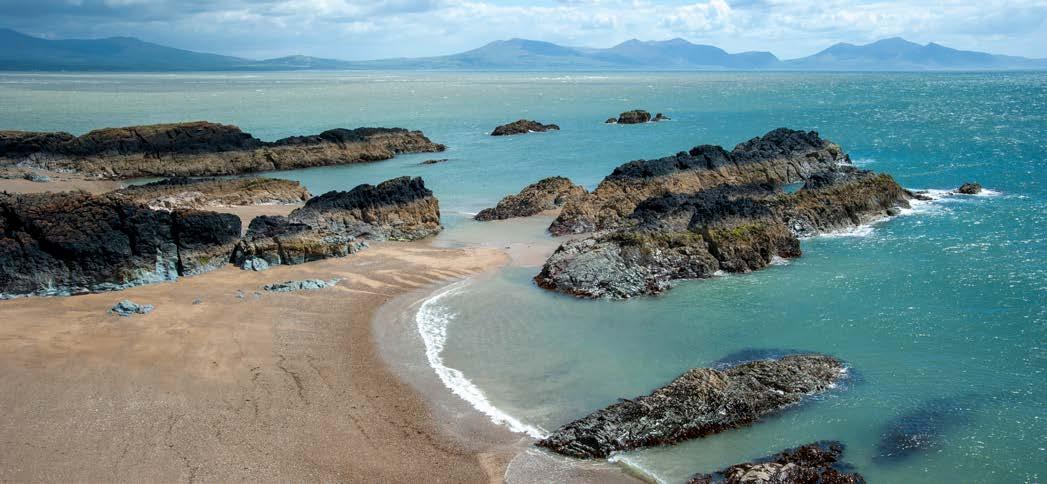
Finally, after 43 years working in the offshore sector, I announce with a mix of good tidings and regret that I am planning to hang up my ‘coloured pencils’ and to retire from my commercial activities in September of this year. I will be attending the five yearly international Offshore Site Investigation & Geotechnics conference in London, September 12-14th 2023, which I have been actively involved in organising and will retire on the 15th when we fly to California for a month to celebrate our first grandson’s first birthday. However, I will continue with my pro bono roles for the foreseeable future including chairing SOSA.
If you are interested in getting involved in any of the activities raised above, please contact me: mick@mickcook.com +44 7593 233633. I always look forward to hearing from you.
Best wishes,
Mick Cook Chairman - School of Ocean Sciences Alumni Association ( mick@mickcook.com )
Since writing my Autumn Chairman’s letter in the latter part of 2022, you will be pleased to learn that we have resurrected the School of Ocean Sciences Alumni Association (SOSA) committee and have indeed held two meetings In December and March with others planned in June and September of this year. I have written a separate article for The Bridge to introduce you to the new committee; so please look out for it in this edition.
Dr Keith Hiscock is a marine biologist and was honoured with an OBE for services to Marine Conservation. He received a PhD in Marine Biology in 1976.

Professor Peter Ghazal is a Sêr Cymru II Professor of Systems Medicine at Cardiff University and was honoured with an OBE for services to Systems Immunology. He graduated in 1982 with a degree in BSc Marine Biology and Biochemistry.

Dr John Siddorn on his appointment as Chief Scientist and Director of Data, Science & Technology (DST) at the National Oceanography Centre. John holds an MSc and PhD in Physical Oceanography from Bangor University.

Dr Iestyn Woolway, a Reader in Physical Limnology, on reaching the finals for the prestigious European Space Agency – European Geophysical Union Earth Observation Excellence Award 2023.

Congratulations to SOS student Evie Mainwaring on winning at Bangor Inclusivity Scholarship.
The scholarships (which cover up to £9500 of course fees) support students who are continuing their studies at Bangor. The aim of the scholarships is to highlight and celebrate the diversity and inclusivity of our student population, to ensure the student voice and experience is embedded in our EDI (Equality, Diversity and Inclusivity) and Athena Swan agendas and to support the career development of our students contributing to these important agendas.
Commenting, Evie, who is from Y Felinheli, Gwynedd and studying for an MSc in Marine Biology said,
“From a young age, I have been interested in pursuing a career in STEM but there were not many women role models within STEM and, like many girls, I was anxious about maths. Over the last years, the percentage of women in STEM has improved which is really positive. I am honoured and grateful to have been awarded the Inclusive Bangor Scholarship to continue my studies in the School of Ocean Sciences at Bangor where hope to be involved in ‘Girls into STEM’ events and inspire other younger women to follow their career ambitions, to find their confidence and realise their capability. I am also really passionate about women’s cricket and increasing female participation in the sport.”

We’re delighted to report outstanding academic promotion success across Ocean Sciences

To Senior Lecturer: Martyn Kurr and Sarah Zylinski
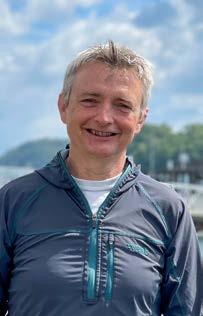
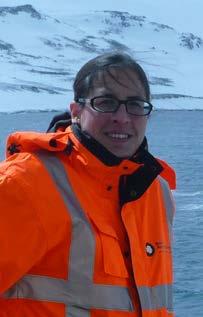

To Reader: Laura Grange and Dei Huws
To Professor: Yueng Djern Lenn, Katrien Van Landeghem and Shelagh Malham


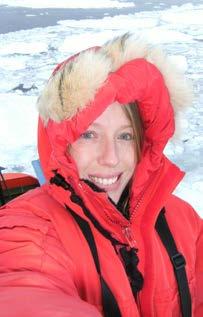


Congratulations to Ocean Science’s Laura Grange (Outstanding Pastoral Support),
Yueng-Djern Lenn (Inclusivity Champion) and
Gareth Williams (Teacher of the Year) on winning student led teaching awards.
Also nominated were Martyn Kurr (Outstanding Pastoral Support) and Sarah Zylinski (Dissertation Thesis Supervisor of the Year).
Congratulations to Molly Jones on winning the student voice employability excellence award.
Congratulations to May Redfern and Noah Church on being nominated for Student Voice Awards.

“I am delighted to be back at the School of Ocean Sciences where I studied at both undergraduate and postgraduate levels between 2011-2019. The last time I was here I was undertaking a PhD (supervised by Dr Martin Skov) where I was studying scale-dependent patterns in salt marshes across the UK to better understand marsh vulnerability. When the opportunity arose to return to SOS as a Welsh medium lecturer I did not hesitate as I knew that I would be working alongside a fantastic team of scientists and staff, once again. Since my PhD I have spent time honing in my teaching skills, working as a project support officer for Technocamps and gaining QTS working in secondary education settings. I believe my wealth of experiences and skills will allow me to bring a different dynamic to the development of teaching and learning within the school. I am also delighted to have the opportunity make a real difference by enhancing Welsh medium teaching and learning within the School of Ocean Sciences; something I am extremely passionate about.”
Molly will be manning the Ocean Sciences stand at the Eisteddfod Genedlaethol 2023 this August.
Why not call in and say hello?
We were please to welcome back MSc Physical Oceanography alumni Bethan Wynne-Cattanach to give a seminar in the School of Ocean Sciences this summer.
Bethan is currently a PhD student at the World Leading SCRIPPS Oceanographic Institution in California. In the seminar Bethan talked about her work on the nature of the ocean mixing which balances the formation of deep water in the Polar Oceans.

This summer Lira Lewis, from Leeds, is to graduate with an MSci in Marine Biology. Following on from her speech at Buchingham Palace last summer (summer 2022 Bridge) she was the keynote speaker at this year’s Leeds City Council Annual Special Educational Needs Co-ordinator conference.

The conference brought together over 150 primary and secondary schools in the West Yorkshire region and Lira spoke about her challenges to education having been diagnosed with severe dyslexia and dyspraxia at age 7.
Lira, who did not learn to fluently read or write until age 14, told the conference how important it is for children to be informed about their diagnosis. Saying “when I finally got my diagnosis, for the first time in my life I felt that I was not stupid, and I was seen by my teachers”. Lira went on to say that “Children with learning difficulties do have their limits but are only disabled by the box that they are put into”.
Throughout her primary and secondary schooling Lira also talked about how she had experienced bullying for her learning difficulties and family’s economic status. Lira said that through the support of her teachers and family, she did not feel alone and was able to find her voice through poetry.
“My secondary school teachers taught me that I did not need to write everything perfectly to express myself. In the lunchtime poetry club, I no longer felt paralysed by my inability to read or write and anytime I preformed poetry it felt like flying. The stress I had known trying to learn to read, or the bullying I experienced melted away when I performed. Through poetry I could explore complex issues that I saw affecting students at my school like the Paris attacks and the Syrian refugee crisis.
In poetry I realised how other students were being targeted simply for who they were, knowing how that felt I just wanted to help but did not know how at 14. Poetry and other youth programmes like the Duke of Edinburgh Awards allowed me to educate myself on the issue so when I could help, I knew how too. I was determined to be successful at my education in order to help and show others in my community, where young people often did not feel like they had a future, that it is possible. I desire to build a legacy where young people feel that building a future for themselves is the norm not the exception.”
Lira has now gone on to publish her first ever poetry book called “Poems of a teenage dyslexic; But I am so much more and there is so much more to you”. The aim of Lira’s poetry is to inspire other young people and includes journal pages for them to explore their dreams and goals. Lira truly believes that with the right support anyone can reach their dreams no matter how small or big.
The inspirational poetry book was published with Barnard Publishing who is another Alumni of Bangor university and 30% of the profits also goes to a non-profit that Lira set up with her mum. The non-profit aims to feed and provide school supplies to children and their families in Leeds. Lira’s dream for the non-profit is that “no child in Leeds ever again goes hungry or is bullied like she was for not having the ‘right school supplies’ ”.
Commenting on her time at Bangor Lira said: “My time at Bangor University has helped me develop the skills I need to understand the impact of our social-economic goals on the marine environment. The support and encouragement I have received over the years from the supervisory staff and the disability services at Bangor has inspired me to become a lecturer. The dedication that the staff of Bangor University have spent teaching about the world of research has genuinely inspired me to communicate that knowledge to other young scientists.”
Lira’s current career plans see her moving to Anglia Ruskin University to undertake a PhD in Macroecology for which she has a fully funded scholarship. In her future career endeavours Lira hopes to build a more harmonious relationship between the environment and our own social economic goals.
Thank you to everyone who contributed to the Sinclair Buchan Prize fund in memory of one of Ocean Sciences most popular lecturers.


The fund as met it’s target and a new prize, to be awarded to the highest achieving first year Geosciences student each year, will be awarded for the first time this year.
Alumnus, honorary degree recipient, and Strictly Come Dancing winner, Hamza Yassin returned to Bangor University this spring to give a talk to students on ‘Life behind the lens’ - he talked about how he became a wildlife photographer and filmmaker.
Speaking to BBC Radio Wales ahead of his visit, Hamza said “I wouldn’t be the person who I am now if it wasn’t for Bangor. I’m severely dyslexic and Bangor University managed to help me tremendously - I didn’t even see it as a hurdle. I then fell in love with natural history and Bangor is just surrounded by the most beautiful landscape, it was the perfect university to go to learn anything to do with marine biology or zoology.”
We’re very grateful to Alumnus Professor Craig Kensler (1961-65) for generously funding the tuition fees for two studentships for MSc taught degrees and the tuition and lab fees for two MSc research degree studentships for each these two years.

This April saw the 19th meeting of the European Geosciences Union (EGU) General Assembly in Vienna with over 18,000 participants from across the planet.

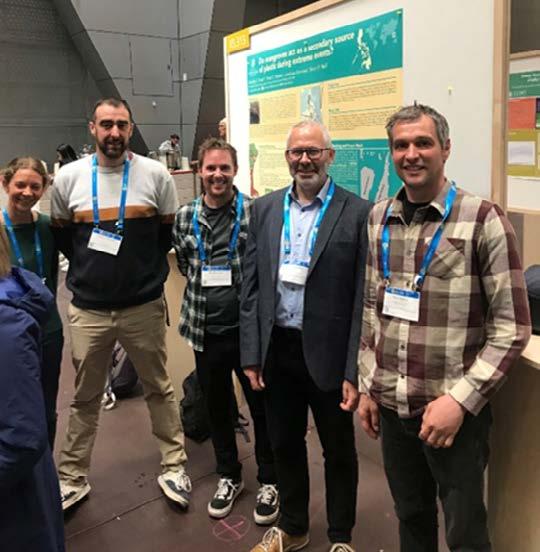
We had a fantastic turnout from Bangor University with over 20 attendees, spanning from undergraduate students to professors. The five-day conference allowed for shared expertise in a myriad of subjects including sedimentology and geology, deep-time modelling, ice-ocean interaction, nutrient cycling, and oceanography. Megan O’Hara, a student in the second year of her PhD said “It was a great opportunity, not only to learn more about what’s happening in your specific field, but to also understand different research areas and wider applications. I was encouraged to meet researchers from all levels and experience a community working together and supporting each other for a common goal.”

The university was able to showcase work from many levels. Jennifer Hewitt presented her MRes project progress in an engaging poster session, whilst Bradley Reed and Iael Perez showcased their Postdoc research. The assembly also allowed for project meetings to take place in person, a much more enjoyable and productive format where it may not have otherwise been possible. Anya Taylor, a PhD student studying to improve Archean climate proxies was able to meet with almost all her colleagues in person, with staff from Uppsala University, Lisbon University and NASA arriving for the conference.
Nia Jones, in the final stages of her PhD, had this to say about the first EGU conference she has been able to attend in person because of the previous online coronavirus requirements, “It makes such a difference being able to attend the conference in person. I found it extremely engaging and exciting, and the hybrid format this year allowed for interesting and inclusive discussions”.
Some of the Bangor team – Sophie Wilmes, Jonathan Demmer, Brad Reed, Simon Neill and Pete Robins – checking out the posters. Nia Jones showing off her poster on the impact of estuarine fronts on the distribution of microplastics in well mixed estuaries. Jennifer Hewitt presenting here work on the development of a novel approach to constraining currents in the Carboniferous geological period using tidal rhythemites.Bangor University’s School of Ocean Sciences holds an annual careers fair in March to highlight the huge jobs potential in one of the fastest growing sectors of the UK Economy, the Marine sector.

It brings our future graduates closer to the job market, and gives students an opportunity to reflect on the skills they likely need for various parts of the marine sector. This year, after hosting the event online for two years, we were so pleased to welcome the exhibitors to Menai Bridge again.
Professor David Viner, Head of Environmental Science at CGG and an internationally recognized climate change, ESG and transition strategist spoke to one of the 160 School of Ocean Science students attending the annual careers fair in Menai Bridge. Other exhibitors included RWE, Minesto, Morlais, Fugro, Robertson Geo, X-Ray Mineral Services, Environment Platform Wales, North Wales Wildlife Trust, Oil Spill Response, Ecoscope, Love the Oceans, Welsh Water, Gwynedd Council and Bark Europa.
The exhibitors gave our students a better idea of what a job looks like in industries that support the energy transition sustainably (e.g. RWE, Minesto, Morlais, CGG, Fugro, Robertson Geo, X-Ray Mineral Services), maintain the integrity of habitats in the oceans, seabed and the coastlines (e.g. Environment Platform Wales, North Wales Wildlife Trust, Oil Spill Response, Ecoscope, Love the Oceans, Welsh Water, Gwynedd Council). Bark Europa was also represented as they are every year, flying in from the Netherlands, and getting our students excited about sailing around the world and education people on board about the important role of oceans in our society.
Organiser Prof Katrien Van Landeghem comments:
With 160 of our students attending and 28 students volunteering to help run the event, our future graduates seem to indeed realise that they can play crucial roles in the delivery of e.g. food, aggregates, minerals, energy, communications, recreation, genetic materials and biodiversity. They can help address society’ worries regarding all these resources and services, and their degree courses at the School of Ocean Sciences have prepared them well to link these challenges to larger-scale climate processes and the crucial role of the oceans. Great skills and awareness together will ensure their future work will make a difference, and this careers fair has helped them figure out exactly how they can do that.”
“The aim is that our careers fairs enable our students to see the diversity in job opportunities in the fast-growing marine sector, and raise the awareness that their fantastic skills as ocean scientists are transferrable to many sectors with interconnecting impacts that increasingly underpin our daily lives.

Bangor Alumni returned last March to the Porcupine MNHS conference to present some of their fascinating current projects.
From marine taxonomy in the labs to photogrammetry on the screen, the 3 day event had it all.



The School of Ocean Sciences were very pleased to host this gathering while presentations were held in Pontio.

We didn’t manage to catch you all on stage, but we hope you enjoyed your return as much as we did!
Thanks also to the current staff and students who all helped and took part with great enthusiasm, including Prof Stuart Jenkins, Dr Craig Robertson, Dr Liz Morris-Webb and Professor John Turner for his welcoming address.
More details of the conference and the society can be found here:
https://pmnhs.co.uk/meetings/2023annual-conference-waves-of-changebangor
Pontoon dipping and a Ribride were among the activitiesThe international Surface Water and Ocean Topography (SWOT) satellite took off from Cape Canaveral in Florida on 16 December 2022.
SWOT will use a revolutionary radar instrument, named KaRIn, to survey at least 90% of the Earth’s surface, measuring and monitoring changes in the ocean, lakes, reservoirs, rivers and wetlands, to produce data that will help improve our understanding of climate change, as well as predict and mediate flood risks around the world.
The project is a multi-agency venture which sees the UK Space Agency working with NASA, the French Space Agency (CNES) and the Canadian Space Agency (CSA) on the mission. The mission brings together the best of British science. UK tech company Honeywell have been brought in to provide unique technology to route vital radar signals around the satellite.
Amongst the SOS Scientists planning to use the data are Professor Simon Neil who will be analysing current data from the Bristol Channel, which has some of the largest tides in the world, and comparing it to the satellite estimates of sea level. Prof Yueng-Djern Lenn will be using the data in her work on the mixing between the Indian Ocean and South Atlantic Ocean off South Africa. Dr Iestyn Woolway plans to use SWOT data in his studies of the impacts of climate change on natural waters.
Acoustic Doppler current profilers being deployed in the Bristol Channel from the Prince Madog to collect current data against which SWOT measurements can be validated.


The image was supplied by NASA and had such a heavy raster that Simpson (Professor of Physical Oceanography at SOS until 2005) thought it might have been a fake created by some mischievous students!
Paper:
JH Simpson and J Hunter (1974). Fronts in the Irish Sea. Nature, 250, 404-406
This image from the 1970s shows sea surface temperature and provided the very first convincing large scale evidence in support of John Simpson’s theory on tidal mixing fronts.
In February 2023 a team from the School of Ocean Sciences led by Prof Yueng-Djern Lenn flew to Cape Town, South Africa to take part in fieldwork for the ‘Quantifying inter-ocean fluxes across the Cape Cauldron hotspot of eddy kinetic energy’ project (QUICCHE for short).
The focus of QUICCHE is to measure how much heat and salt leaks from the Indian Ocean’s Agulhas Current into the South Atlantic where it is mixed into the ambient waters of the energetic Cape Basin. This inter-ocean flux of heat is a key part of the global ocean’s meridional overturning circulation that redistributes heat from the tropics to the poles, impacting weather and climate globally.

Vigorous mixing within the Cape Basin, leading to its reputation as a ‘Cauldron’, is due to the action of large eddies 100s of km across and visible in satellite sea surface temperature data, which break of the Agulhas Current, and the associated swirling of the filaments and smaller scale structures linked to these eddies.
To fully assess how much heat is carried on northwards into the Atlantic need to know how much is lost to the atmosphere and waters below, which is where the Bangor team’s contribution comes in. They measure vertical mixing during the 27-day cruise on the US research ship R/V Roger Revelle.
The cruise was a collaboration between Bangor and Miami, Rhode Island, Gothenburg Universities and the University of Cape Town and involved the deployment of many novel instruments, autonomous vehicles and moorings, to capture the detail of flow in this key region in the global ocean.
The Bangor team, Yueng-Djern Lenn, Martyn Roberts and Ben Powell together with PhD students Sijing Shen and Will Stewart joined the US research vessel Roger Revelle to unravel the processes mixing together Indian Ocean and Atlantic Ocean water masses.


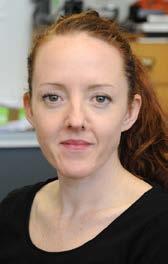
Susan Allender joined an international team aboard the RV Investigator on a voyage into the Southern Ocean to study ocean nutrients in an intensive program of ocean sampling.



The Southern Ocean is responsible for absorbing about 40 percent of the carbon dioxide produced by human activities and its nutrient rich waters support vital food webs and productivity.
The data set collected on this voyage will be unique as voyages to the Southern Ocean are rare during winter due to the extreme ocean conditions at this time of year.
CSIRO (Australia’s national science agency) Principal Research Engineer and voyage Chief Scientist, Andreas Marouchos, said the voyage provided the opportunity for international laboratories to collaborate and share their knowledge.
“The voyage offers a unique opportunity for collaboration and cooperation between global ocean chemistry laboratories that collect data to help us monitor the health and productivity of our oceans,” Mr Marouchos said.
“We’ll spend 14 days at sea working side-by-side in an intensive program of ocean sampling to ensure we’re all using uniform, best practice approaches in the study of our oceans.”
Ocean Scientists in Antarctica recently watched the front of a glacier disintegrate as their measurements ‘went off the scale’.
As well as witnessing the resultant big surface waves they recorded ‘internal’ or underwater tsunamis as tall as a house, a phenomenon previously missed in the understanding of how different water masses mix. The team included Bangor University researchers and was led by the British Antarctic Survey.
The new results show that the Internal tsunamis are an important factor in ocean mixing, which affects life in the ocean, temperatures at different depths, and how much ice the ocean can melt.
Ice in Antarctica flows to the coast along glacier-filled valleys. While some ice melts into the ocean, a lot breaks off into icebergs, which range in size from small chunks up to the size of a country.

The team on board the British Antarctic Survey (BAS) research ship RRS James Clark Ross were taking ocean measurements close to the William Glacier, situated on the Antarctic Peninsula, as the front of the glacier dramatically disintegrated into thousands of small pieces.

Ocean Science’s Geological Oceanographers Prof Katrien Van Landeghem and PhD student, Kate Retallick were part of this team with the responsibility of mapping the seafloor of the fjords directly in front of the retreating glaciers.
Commenting Katrien said:
“After witnessing the sudden calving event up close, the team spotted that the large icebergs breaking off the glaciers caused an “internal” underwater tsunami and mixed the water column. With glaciers predicted to disintegrate even more dramatically in our warming oceans, the importance of understanding the impact such calving events has on the rest of the polar ecosystems should be considered on a larger scale.”
Paper: Meredith et al (2022). Internal tsunamigenesis and ocean mixing driven by glacier calving in Antarctica. Science Advances, 8(47), doi: 10.1126/sciadv.add0720. SOS’s Prof Katrien van Llandegham part of the team investigating the impact of Antarctic Glacial Calving on mixing in the ocean.Moves to use carbon credits accrued by banning trawling could be directing efforts away from more effective methods.
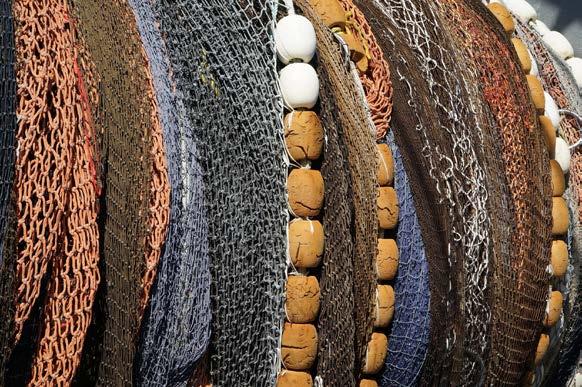
Marine Biology Professor Jan Hiddink has led an international team in refuting the findings of a Nature paper on the amount of CO2 released from the seabed by bottom trawling. The paper by Sala et al made significant headlines around the world on release in 2021, as it equated the carbon released by bottom trawling to be of a similar magnitude to the CO2 created by the global airline industry.
In their paper, also published in Nature, they quantify the carbon benefits of ending bottom trawling, and show that the methodology used in the original paper was far too simplistic and vastly overestimates carbon emissions. In calculating the CO2 released by bottom trawling, the paper modelled the amount of carbon that would be disturbed, and they assumed that most of this would be converted into CO2. However, the majority of this organic carbon on the seabed would decompose and be released as CO2 regardless of whether it is disturbed by bottom trawling. The new Hiddink et al. Paper therefore shows that only a very small fraction of seabed carbon reacts to trawling disturbance.
“The carbon benefits of ending bottom trawling have been massively overstated in this paper” Hiddink explains. “While bottom trawling undoubtedly disrupts the natural carbon fluxes and disturbs the bottom-dwelling sea life, seabed carbon flows are highly complex and need further research.”
Paper: Hiddink, J.G., van de Velde, S.J., McConnaughey, R.A. et al. Quantifying the carbon benefits of ending bottom trawling. Nature 617, E1–E2 (2023). https://doi.org/10.1038/s41586-023-06014-7
Bangor University and The Zoological Society of London have been awarded
£250,000 to run the ‘Restoring Wild Oysters to Conwy Bay’ project on the North Wales coast.

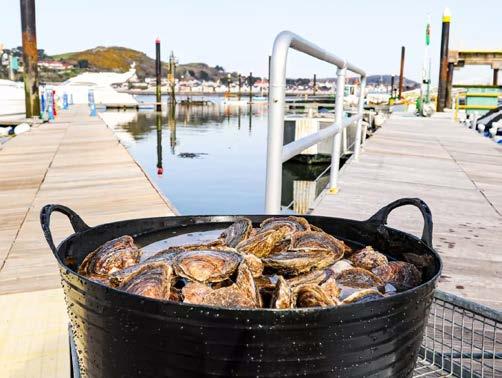
The National Lottery Heritage Fund is delivering the Nature Networks Fund (second round) on behalf of the Welsh Government and in partnership with Natural Resources Wales. The two-year project aims to restore European native oyster habitat and a community of associated organisms.
https://www.bangor.ac.uk/news/01/restoring-oysters-to-conwy-bay-project-receives-funding
A Paper refutes assertion that effects of bottom trawling on blue carbon can be compared to that of global air
In light of RNLI figures revealing there were 1,425 lifeboat launches to people cut off by the tide across the UK and Ireland between 2017 - 2021, the charity has entered the next stage of a collaboration with Bangor University.
The new project is aimed at better understanding people’s knowledge of the tide and researchers are calling for people who have experienced tidal cut off to share their stories.

The collaboration began in 2021, when both parties launched a small-scale survey on social media to understand why people become stranded and often require the RNLI’s help. The results helped to explore why people are getting into trouble and then work on the most effective interventions. A short video was also produced to show how quickly sandbanks become exposed and help illustrate the different states of the tide.
The university has now commissioned a marine social scientist Dr Liz Morris-Webb to unpick people’s awareness of tides, with a view to improving tidal knowledge through new public campaigns and education. With the support of an oceanographer Martin Austin and Bangor Professor of Linguistics, Thora Tenbrink, the University are committed to helping to ensure people enjoy our coastline safely, and the charity to ultimately save more lives.
https://www.bangor.ac.uk/news/bangor-university-shares-expert-knowledge-with-rnli-to-reduce-tidal-cut-offs
Extensive sand banks exposed at low tide in the mouth of the Conwy estuaryThe Prince Madog is the only fully seagoing research ship in the UK’s higher education sector.
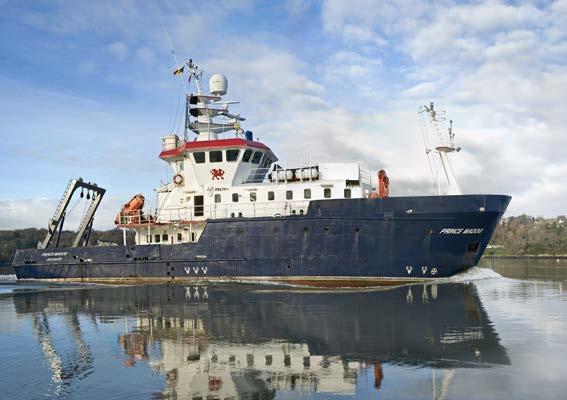
In line with the Bangor University commitment to reduce our environmental impact, the Prince Madog is set to reduce its emissions by up to 60% thanks to a pioneering £5.5 million hydrogen power initiative that could help re-shape the future of shipping.
The Transship II project is the largest retrofit of its kind to-date and will see the Prince Madog retrofitted with a hydrogen electric hybrid propulsion system that will enable zero to low emission operation by 2025.
The project is part of the Clean Maritime Demonstration Competition Round 3, funded by the Department for Transport in partnership with Innovate UK. It will be delivered by a consortium of major UK innovators in green maritime technology and hydrogen systems, led by O.S Energy who own and operate a fleet of dedicated offshore service vessels.
We were pleased to be able to help BBC Springwatch with setting up a practical demonstration of ocean currents when they visited the Menai Strait in June.

If you’ve visited one of our Open Days recently, you’ll have seen Yueng-Djern Lenn using this same apparatus, some ice and bottles of food colouring to explain how cold Arctic seawater influences the Atlantic Gulf Stream and our climate.

Spring comes earlier, autumn later, and summer has lengthened by 5.6 days per decade in Northern Hemisphere lakes.
A new large-scale analysis of lake temperatures provides further evidence of some of the seasonal changes caused by climate change. The research by Iestyn Woolway and published in Nature Communications, uses lake temperature data, both historical and modelled to look at when typical spring or autumn conditions occur in lakes worldwide, to show exactly how much the seasons have shifted in different regions of the world and estimate how seasons will change in the future.

Since 1980, spring and summer temperatures in Northern Hemisphere lakes have arrived earlier (2.0- and 4.3-days per decade, respectively), whilst the arrival of autumn has been delayed (1.5-days per decade) and the summer season lengthened (5.6 days per decade). This century, under a high-greenhouse-gas-emission scenario, current spring and summer temperatures will arrive even earlier (3.3- and 8.3-days per decade, respectively), autumn temperatures will arrive later (3.1-days per decade), and the summer season will lengthen further (12.1-days per decade).
While we may all welcome an early spring and a long warm summer, that reaction would be simplistic. The results can have catastrophic effects for the natural world. Within the lakes themselves, aquatic species respond to thermal cues triggered by the lake temperature. In a stable climate, seasonal events such as spawning will occur at the same time and coincide with other events, which might provide a food source for example.
Paper: RI Woolway (2023). The pace of shifting seasons in lakes. Nature Communications, 14, 2101.

Staff using Bangor University’s research vessel ‘Prince Madog’ collected high resolution multibeam sonar data from over 150 wreck/obstruction sites that are listed on the UK Hydrographic Office database, including 60 sites in the Bristol Channel, 26 sites off the coast of South Wales and 63 located between the Isle of Man and Northern Ireland.
This new dataset includes 129 sites not previously thought to have been surveyed using multibeam sonar, as well as data from more detailed surveys undertaken over several wreck sites (previously surveyed by Bangor University in 2020) that are of potentially historical importance within our Unpath’d Waters project study area to the west of the Isle of Man. Work will now begin on processing the data to produce high-density point clouds for analysis in combination with maritime archives (such as vessel plans, vessel logs and newspaper archives etc) to determine the identity of many of these wrecks which remain unknown.
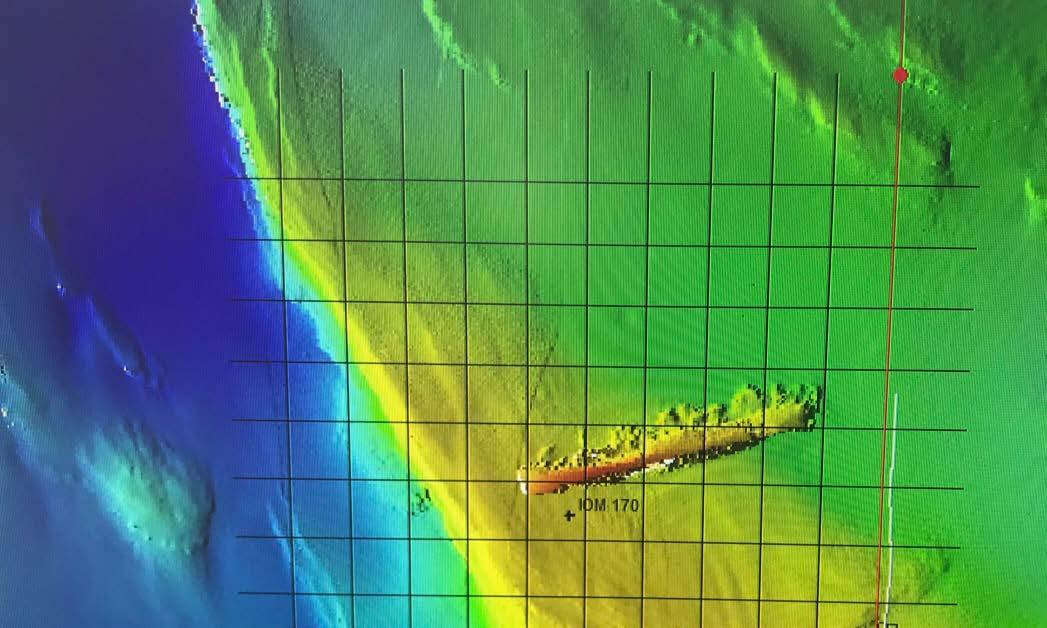
Project Co-I, Dr Michael Roberts from Bangor University commented “this new dataset when used in combination with other scientific data and the wealth of Unpath’d Waters project resources and facilities readily available and under development, has the potential to radically transform our understanding of what lies on the seabed in our study area and provide us with unique and valuable insights on how these sites will change over the coming decades”.
Bangor University’s Centre for Applied Marine Sciences (CAMS) is one of the organisations taking part in the project. Read more details about the project here
A unique and potentially extremely valuable scientific dataset was recently acquired during a research cruise in the Irish Sea.
Unpath’d Waters is a ground-breaking 3-year research project that aims to unite the UK’s maritime collections.
Bangor has been recognised as one of the UK’s leading universities for looking after wildlife – on campus and in the wider community.
A new study has revealed that Bangor University is among the UK institutions doing the most to protect wildlife – meeting 100% of the ranking factors.
The University met the ‘platinum tier’ criteria, with wildlife protection policies, partnerships or funding for local wildlife causes, biodiversity or wildlife activities on offer and regular wildlife surveys. The study, led by wildlife care experts Ark Wildlife, surveyed all UK universities on their wildlife initiatives and support.
https://www.bangor.ac.uk/news/2023-05-19-bangor-university-named-one-of-the-uks-most-wildlife-friendly-according-tonew-data

The University places sustainable development and global citizenship at the heart of its strategy, and now, the latest university league table reflects those aims. Once again the University has ranked in the top 100, placed 64th globally and 16th in the UK when measured against the United Nations’ Sustainable Development Goals (SDGs).
In reviewing 1,591 universities worldwide, the annual Times Higher Education Impact rankings use these SDGs to assess the positive impact of universities.

Bangor University reached the Top 10 in a several categories at the 2023 WhatUni? Student Choice Awards, including a bronze award for University Halls and Student Accommodation.
The University was shortlisted in five categories this year and the results were announced at an awards ceremony last night.
Bangor was 8th in the University of the Year category, which was awarded to Nottingham Trent University, 3rd for Halls and Student Accommodation, 5th for lecturers and teaching quality, 7th for Students’ Union and 10th for Postgraduate.
The What Uni awards are awarded based on the reviews of students studying in the UK.

Welsh Government Minister for Health and Social Services Eluned Morgan AS visited the University today to officially open the new waste water monitoring research facility in the Brambell building.
The state of the art facility enables scientists to test water for the detection and surveillance of human pathogenic viruses and AMR in freshwater, estuarine and coastal environments and track their prevalence in the community through wastewater sampling.
Speaking at the official opening, Eluned Morgan said, “Wastewater data was instrumental in helping gain a better understanding of the spread of Covid-19 in Wales. It continues to provide us with key data which allows us to track the virus though our communities while other UK data sources, like the ONS Covid-19 Infection Survey, have been stood down.
“I’m really pleased that, through this fantastic new facility and the team here, we can apply what’s been learned to gain priceless insight that will inform how we react to many other communicable diseases now and in the future.”
https://www.bangor.ac.uk/news/2023-05-19-health-minister-opens-new-wastewater-monitoring-lab-at-bangor-university

Randall Arauz, a long-time conservationist of Costa Rica and Pew Marine Fellow has been awarded a PhD by Published Works for his work to support the network of interconnected no-take areas and buffer zones between Costa Rica and Galapagos.

His PhD (No-take or no way: The case for a no-take policy along the Cocos-Galapagos Swimway) supported by Ian McCarthy and John Turner, addressed the problem of overfishing by the regional longline fishery by driving for large fully protected marine areas at essential habitats for endangered species, marine biodiversity hotspots, and migratory corridors. The seamounts along the submerged Cocos ridge have been identified as biodiversity hotspots, and the existence of biological connectivity between them and Cocos Island, Malpelo Island, and the Galapagos Islands, has been confirmed through the movements of critically endangered hammerhead sharks. Options were recommended to the governments of Costa Rica and Panama for the future expansion and modification of their MPAs based on best available science.
We congratulate Randall on his important work, and look forward to hearing about his progress through future interactions with the School.
You can see a video about his work here: https://www.youtube.com/ watch?v=z2t8bbDUR5A

Jennifer Pytka’s masters thesis supervised by Alec Moore and Adel Heenan, investigated the internet trade in the bowmouth guitar fish (which has shark-like tail and ray-like head) which is used in the production of jewellery.
The work was recently published in the journal Conservation Science and Practice
https://doi.org/10.1111/csp2.12896
and is the subject of a recent Wildlife Watch National Geographic Article
https://www.nationalgeographic.com/animals/article/thaishark-ray

Hence, we will be celebrating our 30th anniversary in 2024. In order to mark this event, the SOSA committee is in the advanced stages of planning a reunion of our Alumni.
The Alumni event is scheduled to take place over the late May Public Holiday 25th-26th May 2024 in Menai Bridge.
The main event will be a 3-course dinner with wine and welcome drink/canapes in Neuadd Reichel, Ffriddoedd Road, Bangor on the evening of Saturday 25th May. Details are currently being finalised, but it is likely that the cost of the dinner will be £50 per person.
In addition, we are planning several other events over the reunion weekend, including:
• Llanddwyn Outing: On the Sunday morning, we’re planning a guided walk along the beach at Newborough Forest and across to Ynys Llanddwyn. It’ll be a chance for you to hear about the ecological management of the site; to see some UNESCO-designated world-class ancient ocean-floor rock outcrops; or you can simply take-in the fresh air and to bathe in the fantastic views!
• Rib Rides: As per the last reunion, we are planning to offer rib rides on the Menai Strait between Britannia Bridge and Beaumaris.
• Afternoon Tea: For those that like afternoon tea, we will be planning such at Dylans Restaurant, overlooking the Menai Strait to integrate with the rib rides.
• Anglesey Sea Zoo: We are in discussions with Frankie (SOS alumnus and owner of the sea zoo) about offering reunion attendees a tour of the sea zoo.
• Prince Madog: If the research vessel ‘Prince Madog’ is available, we will be offering tours of the vessel over the reunion weekend.
Details of these activities together with any associated costs, will be provided when confirmed in the next few weeks.
Accommodation:
We have secured favourable accommodation rates at the Management Centre and Halls of Residence in Bangor. These should be booked directly with the providers.
Management Centre: Rooms (including Double, Single, Twin, Executive, and Family rooms) are being held for the reunion group. Contact details are:
01248 365912 event@themanagementcentre.co.uk quoting the reference: GA01857
Halls of Residence, Ffriddoedd Site: All single rooms, en-suite, priced at £35, per person, per night (minimum of 2 nights). Use this link, quoting reference ST2023 https://conferencebookaccommodation.bangor.ac.uk
Booking: Details of how to book and to join us for this reunion weekend will be circulated as soon as possible. We do hope you can join us. Why not encourage your cohort to meet for the reunion weekend? I know I will be inviting my former MSc colleagues to join me and my wife, Christine, at the event.
Anyway, in 2022 when I was sure the major impacts of COVID were over for most of us, I decided to re-invigorate the SOSA committee. As a number had retired/moved on since the onset of COVID, and sadly Sinclair Buchan had passed away, I put out a call for SOSA members to join the new re-invigorated committee and received a great response. An inaugural meeting of the new committee was held on the 8th December 2022 and since then we have held our first face-face meeting in Menai Bridge on 13th March 2023. At that meeting we set up a sub-committee to plan and arrange the 30th anniversary reunion referred to elsewhere in The Bridge
The new SOSA committee benefits from then fact that we do not need to hold all meetings face-face, as ‘in the old days’. This has enabled a number of people living outside North Wales to join; and I can honestly say that we now have a very diverse committee in terms of age, gender and speciality. The new committee comprises the following alumni:
Bethan Perkins (BP) Bangor University – Alumni Relations Officer
Chelsea Bradbury (CB) The Crown Estate
Chris Richardson (CR) Ret. Bangor University – Former Head of School
Daniel Lambley (DL) Oil Spill Response – Events Lead
Dei Huws (DH) Bangor University - Reader
Ifer Gwyn BP
John Turner (JT) Bangor University – Current Head of School
Karen Dalton (KD) RPS
Katie Cross (KC) MarineSpace
Katrien van Landeghem (KvL) Bangor University - Professor
Lucy Shuff (LS) RPS - Secretary
Mick Cook (MRC) Mick Cook Limited - Chairman
Ryan Mowat (RM) RSAqua
Further, Lauren Bate, Bangor University Commercial Development Officer, is also assisting us set up the 2024 reunion. In addition, at the time of writing this article, I am in discussion with Frankie who owns and runs Anglesey Sea Zoo about her joining the committee.
The remit of the/your committee includes:
1. To promote and maintain contact between SOS Alumni, primarily through the production of The Bridge.
2. To support both present and future students of the School at both undergraduate and postgraduate levels.
3. To encourage academic staff in their endeavours to maintain a high quality of teaching and research.
4. To assist indirectly in the recruitment of future students into the SOS.
5. To assist with provision of advice to current students and Alumni through the Careers in Marine Science (CIMS) scheme.
6. To assist with the raising of funds to support SOSA and current undergraduate and postgraduate students in the SOS.
7. To provide a link between the marine science industry and the SOS.
8. To organize Alumni reunion events.
Should have any questions about what the SOSA does or should do, or you would like to participate in running the Association, please contact me at mick@mickcook.com
Mick Cook – Chairman – School of Ocean Sciences Alumni Association (SOSA)
As mentioned in my Chairman’s Letter, COVID really hampered proactivity on the SOSA committee front. Indeed, we did not meet at all during COVID, for obvious reasons. But we did keep The Bridge going.
Graduated in 2009 from the BSc Marine Biology and Zoology course and has been a member of the SOSA committee since 2022. Chelsea is the Senior Marine Data and Evidence Manager at The Crown Estate where she works with offshore industries to promote data sharing through the Marine Data Exchange, works to strengthen the UK marine evidence base and manages The Crown Estate’s marine internship programmes.
Professor Chris Richardson, now enjoying retirement but keeps a keen interest in alumni events. Formerly Professor in Marine Biology and Head of School of Ocean Sciences.

Graduated from Bangor in 2021 with a BSc (Hons) in Marine Biology and Oceanography. I’m an Oil Spill Responder providing technical advice, training and active response to oil spills globally and promote academic engagement with industry.
Reader in Ocean Sciences and Director of Teaching and Learning at Bangor University. Dei is also currently Learning and Teaching Development Leader (CELT) for the College of Human Sciences.
BSc in Environmental Planning & Management (2003), ILM 7 Leadership & Management (2014). Former Principal Policy Officer at Snowdonia National Park Authority prior to joining Horizon Nuclear Power as Stakeholder Engagement Manager and subsequently Head of Stakeholder Communications. Now with BP’s offshore wind business as Head of Stakeholder Engagement and part of the team developing Mona, Morgan & Morgan offshore windfarms.
Professor in Marine Biology and current Head of School of Ocean Sciences at Bangor University.








BSc and PhD graduate in 1992 and 2000 in Geological Oceanography and engineering geophysics. Technical Director in RPS Energy (previously Hydrosearch and now a Tetra Tech company), managed the Site Investigation and survey and Marine Consenting and Environmental businesses. Current role in business development and client management in Energy Transition.

Professor in Marine Geology and Geophysics at Bangor University’s School of Ocean Sciences

BSc Graduate, 2010 in Marine Biology & Oceanography. SOSA committee secretary since 2022. Principal Consultant at RPS Group for offshore energy and construction projects, previously Commercial Manager, Deputy Commercial Development Manager, Senior Marine Scientist and Marine Survey Manager for various marine environmental survey providers, including Gardline Limited, and sole trader Consultant, LS Ecology. Sits on the committee for the SUT Marine Environmental Science SIG and the East of England Marine Science & Technology Sector Council, with EEEGR.
Mick Cook
MSc graduate, 1979 in marine geophysics, geotechnics and oceanography. Chair of SOSA since 2011 and former MD of RPS Energy and partner/director of Hydrosearch. Now running my own consultancy, MCL, providing commercial advice to the offshore sector, acting in NXD roles and managing M&A activities.

Ryan completed the Marine Environmental Protection Masters in 2014 is currently Director of Fisheries & Research at RS Aqua. He leads on RS Aqua’s environmental monitoring work with the fisheries, aquaculture and ecological research sectors, and is an expert in the use of subsea acoustics for ecological and environmental monitoring. He heads up RS Aqua’s R&D programme, has won multiple Innovate UK and DASA funding awards, and set up research collaborations with several UK academic institutions. He is a Director at the Society of Maritime Industries (SMI) and Chair of the SMI’s Marine Science & Technology Group.
Alumni Relations Officer at Bangor University.

Director and Owner of Anglesey Sea Zoo and Marine Resource Centre. Her vast experience from working on hands-on conservation projects with critically endangered species in difficult conditions abroad in terrestrial and marine environments makes her a passionate advocate for conservation and sustainability. Frankie spent much of her childhood in North Wales, returned to do postgraduate studies at Bangor University School of Ocean Sciences in 2001.Frankie bought the Anglesey Sea Zoo in 2007 and transformed the business into the only exclusively British aquarium, housing native species with natural sea water and specialising in the captive breeding of endangered species including seahorses and lobsters for reintroduction into the wild. As well as a major tourist attraction and local employer, the Anglesey Sea Zoo is an essential community, research and environmental hub, focussing on sustainability, education and marine conservation and a marine animal rescue centre.
I am sad to let you know of the passing of my very good friend, Dr Mark Pritchard – a warm and generous person with an incredible and inspirational journey. Mark’s path to an academic career was far from straight forward, but a fantastic example to us all. Mark was dyslexic and did poorly in a school system which, back then, did not know how to treat people who couldn’t spell. When Mark was 16, he went to the Mines. Brought up in Staffordshire this was good way to go. Mining for coal wasn’t ideal for him, so he took up an apprenticeship as an electrician in the mines and worked that way for a number of years. He partook in the notorious mining strikes, back in the Thatcher era of the early 1980s. He had firm opinions about that time.
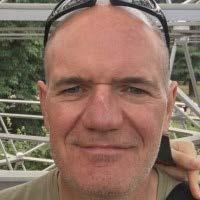
After his apprenticeship, he set up his own business as an electrician, which he ran successfully for a decade. However, he always felt he could do more. He was curious about life and the workings of it, and he was attracted to science. So, alongside all this, Mark worked hard on improving his school grades and at the end of his 20s he got on to an Access course for University. I never knew until the funeral about Mark’s difficulties at school. That was Mark in a nutshell. Not someone to quit on his dreams, but not someone to blow his own trumpet either.
Mark never lingered on his successes in conversation. But, honestly, I’d challenge anyone to achieve what Mark did. He did his BSc in Marine Biology with Oceanography with Bangor over 1993-96. He was talented and hard working, and after that, he was the first of us to get a PhD (Oceanography, Plymouth Marine Lab), the first to get a Postdoc (Woods Hole, USA), the first to get a lectureship (University of Leeds) and the first to quit again as a lecturer – all of that in the space of 10 years. He wasn’t keen on lecturing. Too much admin. So he shifted to work as a Oceanographer with NIWA in Hamilton in New Zealand, in the 2000s.
He loved New Zealand and had a very outdoor lifestyle there, cultivating his love of diving and mountain biking. I still recall diving with Mark on the Coromandel Peninsula on the North Island of New Zealand. We had killer whales, sharks, huge schools of fish and dive-bombing boobies, and BBQ on the beach in the evenings.
Mark was diagnosed with stage-3 cancer about 6 years ago, back in New Zealand. He nearly died in the first months, but fought on to get back to a near-normal life. After a couple of years, the cancer came back and Mark moved back to the UK, to receive specialist treatment and be with his family. Mark wasn’t one to stop and over 3-4 years, while under treatment for his disease, he bought a house that needed a lot of work and did that up to completion. The cancer eventually caught up with him and he died suddenly at home in November 2022, with his daughter, his mum and his sister by his side. In Mark’s own words of goodbye:
“During my journeyman life I’ve experienced and done many different things and been privileged to travel, live and work all over the world. I’ve had many adventures, epic ups and glorious lows, met a lot of incredible people (and some bastards) and many became close friends, not the bastards. I say thank you to all, because at times, I could be really bloody hard work! - Mark Pritchard.”
Thank you Mark, for everything, but mostly just for being you.
Martin Skov (Reader, School of Ocean Sciences, Bangor UniversityWe are sad to learn that Mark Pritchard (11th June 1961 – 24th November 2022), who graduated from Ocean Sciences with a BSc in Marine Biology with Oceanography, 1993-1996 has passed away.
“There comes a point in your life when you wonder why you’re doing what you’re doing, and whether you want to carry on doing it.
This point came to me when I sank knee-high in mud installing an ADCP instrument in freezing seawater with a rapidly incoming tide on the mud flats of the Wadden Sea (north of the Netherlands).
I was managing a data collection project which supplied wave data in winter storm conditions to validate a numerical model. The local authorities would use this model to inform their decisions on what to do with an existing dike to protect the area against future sea level rise.
As I tried freeing my legs from the grips of an unnerving combination of cohesive sediment forces and suction, I took stock of the sticky situation I faced. I was on the wrong side of the dike and most of me was about to be on the wrong side of the sea surface. It would be nice to keep at least my head above sea level - and a cup of warm tea back in the office would also be nice.
My first step towards a new career was on a bearing of 135 degrees back to the coastline. Or at least, a part of it where my ankles would once again feel the sting of the cold winter air after being submerged for the better part of two hours (“better part”?). The journey back to dry and solid land started with my teammates pulling me out of the mud, and then a 15-minute walk over the very sticky, very squelchy mudflat. Very prone to losing a shoe. And some dignity.
I lost one of the first and all of the second.
MARIN has introduced me to a new world of seakeeping data analysis - collecting and analysing data not from the ocean, but from what floats (and hopefully remains floating…) on top of it.

“Seakeeping” is concerned with understanding how a boat reacts to different sea states. Knowing how vessels move in the sea is valuable information in improving onboard conditions such as crew safety and passenger comfort, as well as reducing the likelihood of damage to cargo and equipment, and informing route optimisation decisions.
My new role at MARIN is calculating seakeeping parameters by analysing measured data from scalemodel tests. This is where boats hundreds of metres long are scaled down accurately into models of up to 11 m in length that sail under their own power in a basin nearly 200 m long and 40 m wide. The basin is fitted with some 330 wave paddles distributed along 2 edges so that different sea conditions can be generated. The model boat is surrounded by a carriage which follows and tracks the model as it sails across the basin, measuring its movements and accelerations thanks to a plethora of precise onboard instrumentation.
A whole feast of data is sent from the carriage to the “skybox” - a room overlooking the test basin - where I get to devour it and make sense of it.
We carry out several types of tests, though their nomenclature is somewhat illogical because we refer interchangeably between the vessel’s movement, the water condition, sailing speed or even the test type itself!
For example. “Transit tests” are tests where the boat sails across the test basin, but only in waves and not in calm water. “Calm water tests” are tests where the boat transits across calm water, but doesn’t apply to tests in calm water when its speed is zero. “Zero speed tests” are tests when the boat is in soft mooring (held steady with a system of springs) usually with waves, but not if it’s a “decay test” when the boat is made to wobble in either calm water conditions and at zero speed - or in transit at speed.
Testing a vessel’s response to a carefully determined sequence of wave heights, periods and directions and sailing speeds means test campaigns can run for several days. Often the vessels are set up in various configurations such as different draughts or stabiliser fin and anti-roll tank settings, so the testing time can easily double up.
Now I work at MARIN - a Dutch company specialising in maritime researchwhere the office is warm, dry and just 5 steps away from a coffee machine.
It’s a busy, hectic time in the basin, and it’s followed by several weeks’ data analysis when the data are worked up into sea keeping parameters. These help address questions such as “What are the effects for the crew, the passengers and the cargo when the boat is hurled about by waves?”
There are parameters for everything, ranging from the motion illness rating (how sick someone feels) to the “response amplitude operator” which helps determine the effect that a tested sea state will have on any of the vessel’s 6 degrees of motion.
Everything is carried out with safety, operability and comfort at heart. For example, translating acceleration forces from the position of the accelerometer instrument on the model to a more useful location like the lounge deck or cargo hold helps to inform whether yacht passengers can sip their wine without spilling it, or how securely cargo needs to be fastened. Distribution functions of wave troughs and crests by the keel and deck provide an indication of how often a ship’s propeller might find itself out of water, or how often crew and passengers will be splashed by a wave.
My days as an ocean scientist using satellites in orbit higher than 1000 km to determine sea level rise to millimetre accuracy were fascinating! And ground-truthing the ocean itself with direct measurements was eye-opening. The effects of sea level rise are well known; the effects of the sea states on vessels…I’m working on it! In both cases the end goal is the same - to keep our heads above sea level!”
The picture of a bridge I’ve shared is the bridge of a ship from MARIN’s virtual reality simulation centre. This provides a realistic simulation of the behaviour of vessels and their interaction between maritime structures, the environment and humans, and is where, for example, captains practice their manoeuvres and directly experience the consequence of their decisions.

I am currently coordinating the United Kingdom Marine Strategy Part One assessment in relation to Eutrophication, Contaminants, Litter and Noise.
During the King Charles III coronation weekend, I spent just over 24 hours on the A48 Severn bridge and ran back and forth to cover 100miles. This was a tough going, but a fun adventure race. I finished 2nd! Here are some pictures taken by Kelp and Fern photographers and others.”


“I hope you are all well. Here’s a quick update from me! Work at the Centre for Environment, Fisheries and Aquaculture Science (Cefas) is going well.
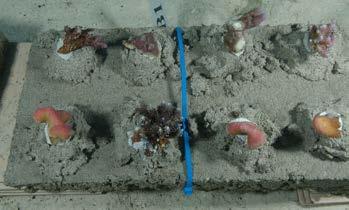

I was a mature student at the time with a good lady (still am) back in Warrington so I spent the week on the Island and weekends back at home, the Friday train is something I am glad to forget. I lived in Llangoed, so I biked it to and from the School of Ocean Sciences, I still remember having to pedal downhill when the wind was against you. My most vivid memory, one which has stuck with me, was going out in the Straits plankton netting at night, it was pitch black of course but the vivid neon blue bioluminescence of the phytoplankton in our bow wave is something I will never forget. I have been down a few times since but never at the time when that algae was around.
After graduating I opened a marine aquarium outlet in Warrington which came to be a nationally recognised centre, and travelled a few times a year to Sparsholt College Hampshire where I was their consultant of Marine Aquatic Studies, I also contributed to national aquatic magazines on a monthly basis.
During this time as I was quite good at cultivating hard corals, I went to Indonesia to teach the local population how to cultivate corals, and transplant them into damaged reefs. To cut a long story short I became disillusioned with the trade as a whole and how damaging it was, despite my efforts, so I left and went back to University (again) and completed my PGCE.

As there was at the time and still is a huge shortage of good physics teachers, I was asked to forgo biology and move to the dark side and teach physics. Which is what I do today and love every minute of it. Whilst doing this I missed my first love, the ocean life, so I wrote 3 books about it.
None of this I could have done if it was not for my time at Bangor, huge thanks to everyone from those years, the Professors, Drs, lab technicians and fellow students, huge thanks.”
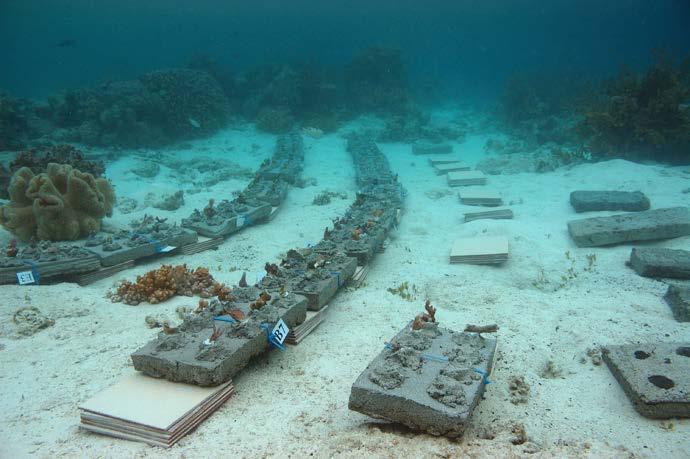
“
I studied at Bangor between 1993 and 1996, it seems so long ago now, but still seems like yesterday.A younger me cutting corals on a boat and the first coral farm in that area.
I loved Bangor, especially because I met the most beautiful woman in the world and 47 years and 3 wonderful children later we are still together. I did a palaeolimnology PhD at what was then Liverpool Poly, supervised by Dr Gareth Evans. I taught in Sixth Form Colleges, A level Biology, then Head of Science. An obsession with assessment of learning led to a move to what was then the University of Cambridge International Examinations, where I ran International Biology qualifications up to A level. It was a great job and suited me as someone who lives on the autistic spectrum, with a very structured year, but opportunities to do things like training teachers in exotic locations.
I also became interested in the management of change and so that formed a significant part of my work for a few years. Then came a training opportunity in a far-flung location I knew well, and a couple of unexpected falls. I could also see my leg muscles squirming involuntarily (fasciculations). I stood on a beach on the last evening photographing the sunset, with tears rolling down my cheeks because I knew I wasn’t coming back.
After a long diagnostic process and early retirement because falling and dropping things in a lab isn’t a great idea, I now live with a rare slowly progressive motor neurone disease. From the wreckage emerged Rick the artist, determined to remain positive no matter how hard it got, and astonished to find that even when unable to hold a paint brush or oil pastel, I could teach my computer to create virtual brushstrokes indistinguishable from those I had made on the rare occasions I had time.
Now I paint without brushes, painting hope. Pictured is a copy of my latest painting, ‘Giverny Grace’, featuring the bridge in a rather more famous artist’s garden. The context for the painting is grief. My mother died from Alzheimer’s disease in March 2023; reunited at last with my father Dr J. D Nelms, who died in 1981 from what he thought was the infectious motor neurone disease, polio, but turned out to be multiple organ failure caused by Leptospirosis. So, a painting of beauty, in the context of grief, yet set in an overarching context of hope, so much hope.
I am still a working volunteer scientist, now as a patient fellow for the MND Association and International Alliance of ALS/ MND associations. I am an advocate in the world of degenerative neurological conditions, the motor neurone diseases, the Alzheimer’s group of conditions, the Parkinson’s group of conditions and others. In this world we make short, intense friendships because time is limited. I would not have missed the friendships I have already had for anything you could name. This next few years is the really pivotal turning point, with our ever developing understanding of the inter and intracellular processes driving neurological degenerative conditions, bringing into play greater and greater opportunities to design therapeutics. So there is hope for longer friendships. A bridge to a future with fewer and fewer degenerative neurological conditions.
My change management experience has converged with my art input at the Arthur Rank Hospice (for example training staff and volunteers to help patients paint from photos using iPads – what a great opportunity for legacy creation when you are living with a life-limiting condition), to lead me into a project at the Fitzwilliam Museum in Cambridge. There I am a community participant on the Connections group. This in turn has stimulated my creativity resulting in a series of paintings, yet to be released. https://fitzmuseum.cam.ac.uk/research/projects/making-connections-through-collections I am also just starting to work with an internationally renowned MND research team, visualising their work in a series of paintings; if I could write, the ink would still be wet on that arrangement.
Thank you to Rev Julie Norris from Under the Thinking Tree, where I am artist in residence, for the beautiful photo of Giverny, taken just a few weeks ago, and for shared human experience and wisdom. I added all the birds, mallard, long-tailed tits, robins from my beloved wife Sue’s photos (we met at UCNW Bangor in 1976), a heron and a marsh harrier. I write more about grief at Under the Thinking Tree. You can buy a copy of any of my paintings by contacting me on drrickz@gmail.com The high resolution file will cost you a donation to the Arthur Rank Hospice who look after us so well, and about £25 for an art quality print you can purchase from any well known printer. It is easy to see more of my work by searching for Rick Nelms; I am every hit on the first page.”
https://underthethinkingtree.com/ricks-paintings
https://www.flickr.com/photos/drrickzt (lots about living on the autistic spectrum)
https://drrickblog.wordpress.com (a click on cats can be recommended)
https://www.bordertelegraph.com/news/19625926.artists-incredibly-grateful-doddie-foundation (the painting seen by far more people than any other)

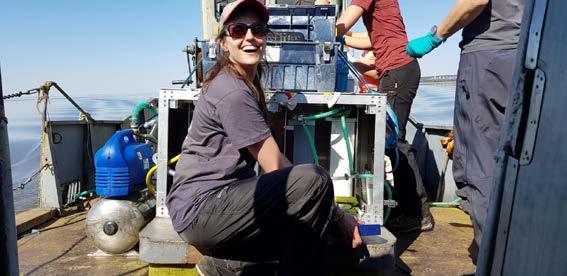

“Firstly, to introduce myself, I am the founder of Atrium Environmental. I completed both my BSc (Ocean Science) and MSc (Marine Environmental Protection) at Bangor between 2009-2013, cementing my ambition and passion to have a career focusing on the oceans. Following my studies, I worked abroad on conservation-focused diving projects but after a couple of years, I re-joined academia to pursue a PhD in Chemical Oceanography in Germany. My PhD was part of C-CASCADES, an EU Horizon 2020 Marie Curie ITN Initiative where there was a heavy focus on industry and academic collaboration. I was jointly based between GEOMAR Helmholtz Centre for Ocean Research Kiel and a marine sensor company, to adapt and optimise their oceanographic CO2 and CH4 sensors for freshwater applications. I utilised the sensors to understand the carbon dynamics of varying salinity surface waters with three sampling areas of the Baltic Sea, South Atlantic Ocean, and the Danube Delta in Romania, which became my key area of focus due to boundary water conditions.
I then transitioned to my post-doc research working in Northeast Siberia on the Kolyma River, focusing on CH4 and CO2 fluxes during the permafrost meltwater summer event. I then left academia and worked as Business Development Manager for a maritime company, while shaping the idea for my sustainable consultancy company (Atrium Environmental).
The idea began initially during my PhD, where I was privileged to work with people working in environmental policy, leaders in these fields, as well as with industries from a range of disciplines. Throughout this time, one consistent learning that was highlighted and observed was the miscommunication, misunderstandings, and lack of transparency between different stakeholders. This is where Atrium Environmental built its foundations which grew over time.
Atrium Environmental was founded in Germany in 2021, however fully focused on from the end of 2022. We are a sustainable consultancy focused on the maritime industry. We work with companies to reduce their climate impact and build a sustainable, long-term strategy in-line with policy and future climate adaptational needs. We focus on tackling problems collaboratively through industry, applying an academic mindset, and the determination to be a pebble in the tidal wave of change.
We integrate closely with companies to support them and utilise our large network to facilitate collaborations between industry and academia, to ensure solutions are based on a strong scientific approach. We promote clear communication, enabling effective engagement with a broad range of stakeholders, to ultimately enable a positive impact. Atrium Environmental is dedicated to implementing initiatives that drive sustainability, including but not limited to, consulting on carbon reduction projects, sustainability assistance with eco-tourism, sustainable strategies for the maritime industry, and utilising water resources in a smart and efficient manner.
We work on:
• Collaborations within EU Projects
• Environmental consulting
• Sustainable adaptation strategies
• Project development and implementation
• Carbon emission data analysis

• Transparency through outreach material
We are always looking to extend our network, build bridges, and accelerate our impact to reduce the climate crisis. Whether that is in the form of collaborations, new partnerships, or experts working in the field. Creating a sustainable future through an atrium of knowledge.
Interested in learning more?
Get in touch here: info@atriumenvironmental.com or check us out on www.atriumenvironmental.com

Daniel currently works as Chief Scientist aboard the expedition vessel, Viking Polaris, and is a Visiting Researcher at Exeter University.

In early 2022, whilst on location in Antarctica, a Giant Phantom Jellyfish was spotted from the ship’s submersible down at 80m. Reaching up to 10m in length, the Giant Phantom Jellyfish is rarely sighted - indeed, this was only the 127th record ever.

“It is extraordinary that we know so little about such large marine creatures as the Giant Phantom jellyfish. However, with scientifically equipped expedition cruise vessels we now have the means to make regular observations in remote regions and at greater depths than previously possible, which provides an exciting opportunity for discovery.” – Dr.
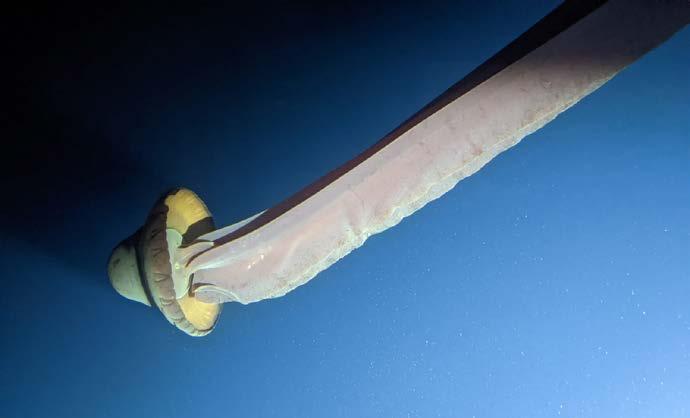 Daniel Moore
Daniel Moore
A research note about these Giant Phantom Jellyfish sightings was published in Polar Research earlier this year and can be read here. It generated a huge amount of public and media interest, leading to coverage in National Geographic online, Forbes, LiveScience, IFLScience amongst many others.
Daniel has recently returned from a second season in Antarctica, where he led research into the effects of penguin colonies on fish populations, as well as a second submersible survey project this time investigating benthic communities.
You can follow Daniel’s research and expeditions on Instagram: @marinebiologylife www.danielmmoore.com
My responsibilities include working on the continuous development of the Marine Data Exchange (MDE), The Crown Estate’s offshore marine industry data platform.
Originally developed in 2013, the MDE is a world-leading resource of marine industry survey data, research and evidence.
Though we are celebrating 10 years since the MDE first launched in 2013, The Crown Estate’s data delivery clause was first introduced in 2003! That means that The Crown Estate have been collecting data and evidence for over 20 years.
By making the wealth of data collected by offshore industries freely available through the MDE, we give offshore projects in the UK a valuable head start, helping those involved to make informed, evidence-based decisions.

Industry data can also be used to help inform academic studies. For example, we are very excited to be working with Bangor University on a PhD starting in October with Dr Craig Robertson, exploring benthic ecosystem functioning. In this study, data from the MDE will contribute to the evidence base used for analysis. From bathymetry to bird data and geophysical to metocean, the MDE has a huge variety of data rich survey content, free and accessible at the click of a button. This data can be used to educate the next generation of marine industry experts.

To celebrate our 10th anniversary, we are revisiting surveys and reports that have been delivered to the MDE over the last decade. Check out our Story by following the link:
The Marine Data Exchange: 10 Year Anniversary | Marine Data Exchange
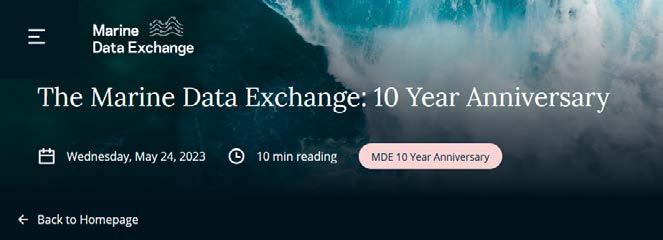
My name is Harriet Baldwin and I work as a Marine Evidence Advisor at The Crown Estate. I studied a Masters in Marine Environmental Protection at Bangor University, and am very happy to say that I am now applying the lessons learned during my Masters to my role in the offshore marine industry.

The publishers describe the book as:
“A fascinating and original look at how the sea has defined Britain - and decided the course of its history - for thousands of years. Being an island nation is a core part of the British identity.
An estimated two thirds of the world’s population have never seen the sea, but in the UK that drops to under 10 per cent. Yet most people don’t appreciate the impact our position on the edge of a continental shelf has had on our history, going back thousands of years.
Our coast neither starts nor ends at the beach, and this eye-opening book takes a look beneath the surface to explore the forces of nature that have made Britain what it is. We experience some of the highest tides on the planet and we are battered with waves that have travelled halfway around the globe before they get here, but most of what we understand about our unique waters has only been discovered in living memory.
In this fascinating guided tour of the fantastically varied British coastline, Professor David Bowers combines oceanography with maritime history, explaining tides, currents and waves in an accessible way whilst revealing how they have been responsible for both salvation (the Channel alone checked the Nazi advance in 1940) and disaster (such as the catastrophic 1953 flooding that led to the ingenious development of the Thames tidal barrier).
He covers everything from how ocean swell waves were first recorded here in preparation for the D-Day landings, to how the first underwater light measurements paved the way to modern ocean satellite observation.
This is a story 8,000 years in the making, ever since the country broke away from mainland Europe in the Mesolithic era, and in his insightful and irreverent telling of it Professor Bowers shows that the British Isles are defined by the sea, regardless of whether you look at them from land or water. With exclusive photos and specially commissioned illustrations, the book encourages you to visit all the places it explores, but when you stand on the beach or clifftop you will never think of Britain in quite the same way again.”
https://blackwells.co.uk/bookshop/product/Home-Waters-by-D-G-Bowers/9781472990686
our seas?
Bangor researchers are part of a major new UK consortium which has just won £2.5 million in funding from the Natural Environmental Research Council to investigate the environmental impacts of the proposed development of a new generation of floating wind farms on the marine environment.
Following the huge success of the development off-shore wind as a renewable energy source over the past decade, a further fourfold expansion in this form of energy capture is seen as the backbone to the UK (and many other coastal nations) pathway to achieving NetZero by 2050.
Whilst over 99% of current generation of UK off-shore wind farm development is based in shallow tidally turbulent and, in consequence, well mixed coastal seas, the proposed massive expansion requires large scale developments in the deeper seasonally stratifying seas further from shore, as is already proposed in the North and Celtic Seas.
This regime shift requires the development of radically different turbine foundation designs, with a switch from the current generation of seabed fixed turbines to novel floating mountings. This move implies a very different environmental response and raises questions as to the impact of these new developments on nature and the environment?
The proposed developments of deep-water floating wind farms in what are considered some of the most biologically productive seas on the planet, the seasonally stratifying shelf seas. The new research will examine the impacts of the new developments on these sensitive ecosystems, and in particular the turbulent wakes associated with tidal flow past the floats, and the associated mixing.
These developments could produce some very positive aspects on the marine ecosystem, such as mitigating some of the impacts of a warming ocean. It is hoped that the new research will guide design and planning of these vital new developments to ensure they are sustainable in protecting local wildlife.
Could these floating wind farms have a positive impact on fisheries?

Beyond protecting wildlife, these new developments could also help to generate new fisheries, as proposed in a paper by Bangor University Ocean Sciences scientists John Simpson and Paul Tett 36 years ago!
Commenting Post-doctoral Research Fellow Ben Lincoln says:
“Floating offshore wind provides a huge opportunity for the UK in reaching NetZero, and also in creating jobs. Over 50 years of novel research here at the School of Ocean Sciences shows us that that optimisation of float design and warm farm layout could help mitigate against the negative impacts of negative impacts of climate change as well helping grow new sustainable fisheries in these regions.
“We hope that the science we plan will help in ensuring the maximum positive impacts and ensuring that these developments are sustainable.”
The new research involves Tom Rippeth, Ben Lincoln, Ben Powell and Martin Austin.
Bangor University are working in partnership with Natural Resources Wales and the Centre for Environment, Fisheries and Aquaculture Science to monitor dolphins, porpoises and underwater noise off the coast of Anglesey.
Recording equipment has been deployed off the coast of Anglesey to monitor dolphins, porpoises and underwater noise over an 18-month period to understand how mammals, like harbour porpoise, bottlenose dolphin, Risso’s dolphin and common dolphin, use the area.



Natural noise includes strong tidal flows carrying sediment, weather conditions such as wind and rain on the surface of the sea, waves, and other marine life, while noise from human sources includes ships and boats, sonar, and the construction and operation of marine industries.
This project has received a grant from the Nature Networks Fund which is funded by the Welsh Government and delivered by The National Lottery Heritage Fund in partnership with NRW to help tackle the nature and climate emergencies.
Gemma Veneruso from the School of Ocean Sciences at Bangor University said,
“It’s great to be partnering with Natural Resources Wales and the Centre for Environment, Fisheries and Aquaculture Science on this project.
The School of Ocean Sciences has considerable expertise in marine mammal acoustics which is a powerful tool that records sounds made by dolphins, porpoises and even whales for months at a time. This allows us to understand how often and when these animals use the waters off Anglesey and if human influences such as ocean noise has an impact on their activities. Much of the coastline around Anglesey is designated as a Special Area of Conservation (SAC) for the harbour porpoise and bottlenose dolphins from nearby SACs in Cardigan Bay are known to use these waters as well, so it is critical to monitor and conserve these populations”.
A Welsh Government programme to test wastewater for COVID-19 in which Bangor University is a lead partner has added communicable diseases and hospitals to its capabilities.

The programme provides vital data on the prevalence of coronavirus in the community and adding these key sites and additional communicable diseases to the monitoring already in place across Welsh health boards and local authorities will deepen the insight and localised knowledge required in public health decision-making.
Scientists from Bangor University, including SOS Dr Shelagh Malham, initially developed the process of testing wastewater for COVID-19, and this work, carried out in partnership with the Welsh Government, Cardiff University, Dŵr Cymru Welsh Water and Hafren Dyfrdwy was used in the early detection of the Omicron wave across Wales.
As well as testing for SARS-CoV-2 and other variants, the team have now established methods for testing for other viruses of interest, including Polio, norovirus and other stomach bugs, influenza and the respiratory virus RSV and antimicrobial resistance. The next stage in the development of the programme sees the existing programme partners work with closely with Public Health Wales to monitor wastewater at nine hospitals in Wales and to expand on the surveillance of Polio viruses following the detection of a vaccine derived polio virus in London earlier this year.
https://www.bangor.ac.uk/news/2023-01-12-wastewater-monitoring-programme-extended-to-include-hospitals-andmonitoring-beyond

Most of Antarctica’s coastline is fringed by floating ice shelves. Many of these ice platforms are thinning through a process called basal melting.
This ocean-driven process influences how much the Antarctic Ice Sheet is contributing to global sea level rise. A new paper led by Physical Oceanography MSc student Josephine Anselin provides a new understanding of the mechanisms that drive basal melting which will help to improve the accuracy of sea level projections.
Josephine and the team used a novel computer model to study how currents generated by tides influence basal melting. The model predicts that tidal currents generate an increase in basal melting. However, we also show that the results are sensitive to how the effects of tides are represented in the computer code. These important new results will provide a new way of representing the impact of tidal currents on basal melt rates in global climate models.
Josephine is now studying for a PhD with British Antarctic Survey. J. Anselin, B. C. Reed, A. Jenkins, J. A. M. Green (2023). Ice Shelf Basal Melt Sensitivity to Tide-Induced Mixing Based on the Theory of Subglacial Plumes. Journal of Geophysical Research: Oceans. https://doi.org/10.1029/2022JC019156.The impact of rising sea levels on our coastlines can be profound. A natural shoreline can respond to sea level rise and coastal erosion, provided the rise isn’t too rapid.
Given enough time, flora and fauna may have a chance to adapt. But a coastal area which has been heavily developed will respond differently, sometimes with catastrophic impacts on both people and nature.
Fairbourne is a small village on the west coast of Wales and is the first place in the UK to have been assigned the long-term policy of “no active intervention” regarding its coastal defences. That is when a decision is made not to invest in providing or maintaining sea defences.
This has led to Fairbourne’s inhabitants being described as “the UK’s first climate change refugees” by news media.
In the UK, regional shoreline management plans (SMPs) are developed for managing coastlines from flood and erosion risk. SMPs consider the potential risks and select from a range of options, consisting of building new sea defences, through to the aforementioned “no active intervention”.
In Fairbourne’s case, the SMP suggests it will neither be safe nor sustainable to remain in the village by around 2054. The intention is for the authorities to monitor and maintain the existing coastal defences in the short and medium term.
Ultimately, the village may be decommissioned, although details are scant on what that means. It remains a contentious issue and the community continues to fight for increased support from government organisations.
At the turn of the 20th century, Fairbourne was just a cluster of houses on the Gwynedd coast at the mouth of the Mawddach estuary. Over the past 100 years, the village has expanded to around 460 properties. It has around 700 inhabitants and is popular with tourists.
Fairbourne is built on a low-lying floodplain. The village lies between cliffs and a natural gravel barrier which houses a sea wall, and is at risk from both coastal and river flooding. As the sea level around the Welsh coast rises, the village is at increased risk from coastal flooding.

There are two main factors which drive global mean sea level rise, both related to climate change. First, the addition of freshwater to our oceans from melting glaciers and ice sheets. And second, the expansion of ocean water as it warms up, which is a consequence of higher atmospheric temperatures.
The global mean sea level rose higher in the 20th century than in any other century during the last 3,000 years. The rate of global mean sea level rise in 2021 was the highest ever recorded. Uncertainty remains in the projections of future sea level rise but the latest estimate is that a global rise of up to approximately 1 metre by 2100 is possible.
The response of a natural gravel barrier coastline to sea level rise is mainly controlled by the amount of nearby sediment and the rate at which the sea level is rising along that section of coast.
Where there is available mobile sediment, a barrier will move towards the land under rising sea levels. This process is called “rollover”, as sediments are pushed up and over the crest of the barrier towards the land.
However, if the barrier is prevented from moving or if the sea level rises rapidly, more significant structural changes can happen. First, the barrier tends to get steeper, which then promotes more energetic wave breaking.
In time, the barrier crest becomes vulnerable which can lead to it being breached. In the case of Fairbourne, which is behind such a barrier, a breach could result in the village being flooded.
Second, the barrier needs time to adapt to changes in sea level. When the level of the sea rises rapidly, the barrier cannot evolve quickly enough to keep up.
In Fairbourne, these factors combine to increase the flood risk to the community. The sediment supply to the gravel barrier is limited. To compound the issue, as the sea level rises, the water becomes deeper which leads to less available wave energy for pushing sediments onshore.
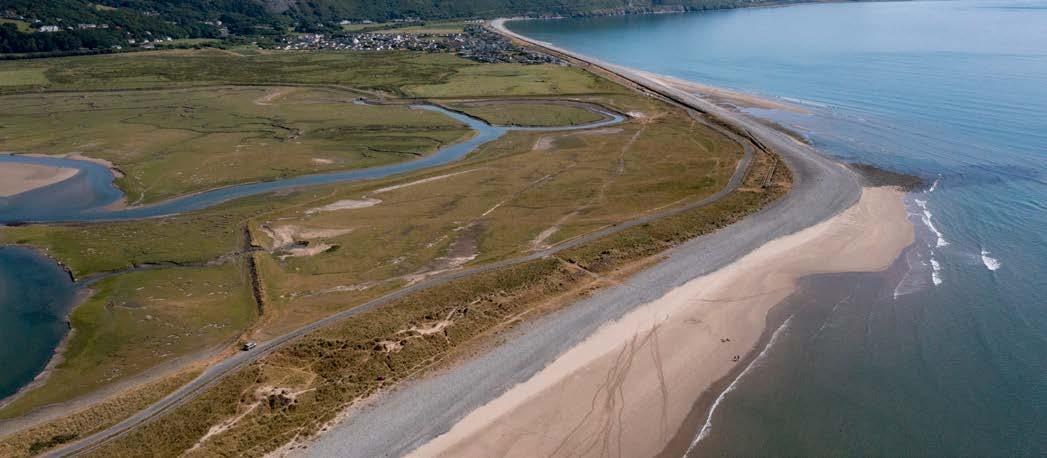
The potential for Fairbourne’s seaward barrier to shift towards the land is limited by the lack of space. The barrier is somewhat trapped between the hard rock of the cliffs and the nearby Afon Mawddach.
What’s more, the existing seawall fixes the crest of the barrier in place and therefore increases its vulnerability. Meanwhile, the sea level continues to rise.
Physical and environmental factors aside, sea level rise is a complicated socio-economic issue. Regardless of the financial cost, building coastal defences is not always the best method of adaptation.
The UK’s SMPs provide a strategic approach to coastal management and defence. However, retreating from the coastline, disbanding communities, abandoning homes and decommissioning villages such as Fairbourne really is the ultimate form of adaptation and so requires careful consideration.
Given around 10% of the world’s population live in coastal areas fewer than 10 metres above sea level, this is a topic we’re likely to be discussing a lot more in years to come.
https://theconversation.com/the-uks-first-climate-refugees-why-more-defences-may-not-save-this-village-from-rising-sealevels-197206
Being able to produce and detect sound in an environment where light penetrates only a few hundred metres is crucial for animals to communicate, feed, avoid predators and navigate vast underwater habitats. Large whales generate low frequency communication calls that can travel thousands of kilometres. While the snapping shrimp, native to the western Atlantic, can produce a loud snapping sound capable of stunning and killing its prey.
The noise generated by humans changes the natural acoustic environment of our oceans and our capacity to produce it is increasing. Noise is often the unintentional byproduct of transport, infrastructure development and industry.
Yet noise can also be produced deliberately. Many navies use sonar to detect ships and submarines, while geologists survey the seabed for oil and gas using seismic airguns. The noise produced by an airgun can exceed 200 decibels (louder than a gunshot at a range of one metre).
Sound travels further and four times faster in water than in air (at a speed of almost 1,500 metres per second). The noise produced by humans can therefore spread considerable distances underwater. These sounds can be relatively constant, such as the noise produced by a ship’s engine and propeller, or sudden and acute in the case of naval sonar and seismic airguns.
The sound produced by a seismic airgun can cause permanent hearing loss, tissue damage and even death in nearby animals.

Evidence for the lethal effects of noise can be hard to document in the open ocean. But seismic surveys have been linked to the mass mortality of squid and zooplankton. In 2017, research revealed that a single air gun caused the death rate of zooplankton to increase from 18% to 40–60% over a 1.2 kilometre stretch of the ocean off the coast of southern Tasmania.
The use of naval sonar has also been associated with the mass stranding of several whale species in the Caribbean, Europe and East Asia. Mass stranding events involve entire pods of animals simultaneously beaching themselves.

Bangor
Oceans are full of sound. Waves, earthquakes and calving icebergs all contribute to the underwater soundscape. But so do human activities, and this can be a problem for marine life as it can seriously affect their physiology, behaviour, reproduction and even survival.Examination of the dead whales revealed they had suffered trauma similar to decompression sickness. This was believed to have been caused by sudden changes in their deep diving behaviour following exposure to sonar. Mass stranding events have been linked to the use of naval sonar.
Over the past two decades, research has also revealed the widespread impact of chronic noise exposure on animal behaviour and physiology. These impacts can extend well beyond the noise source and affect vast areas of the ocean.

Laboratory studies on the sea hare – a marine slug – revealed that exposure to boat noise led to a 21% reduction in successful embryo development. Individuals that hatched also suffered a 22% higher death rate than sea hares that were not exposed to boat noise.
These findings demonstrate the negative effects that a common source of underwater noise can have on animal development and survival. If these laboratory results can be applied to natural environments then such impacts could threaten entire populations of marine species in particular areas.
Observing the movements, feeding, communication, resting and social interactions of animals provides scientists with a method for exploring the effects of noise.
The behavioural impacts of noise on marine mammals are particularly well studied due to conservation concerns and their reliance on sound for communication, foraging and navigation. Many of these species move large distances and long-range communication is crucial for coordinating social interactions and reproduction.
But the sounds produced by large marine mammals are of a similar low frequency range to much of the noise produced by humans. The noise produced by ships tends to be below 2 kHz which overlaps with the vocal frequencies produced by many large mammals. Blue whales, for example, produce frequency vocalisations of less than 100 Hz meaning their calls can be lost in the background din.
Shipping noise has led to marine mammals altering their vocalisation patterns. This includes making calls longer and more repetitive or waiting until noise levels drop before calling. Research has shown that shipping noise made within 1,200 metres of humpback whales has caused the whales to either reduce or stop their calling in the waters surrounding the remote Ogasawara Islands in Japan.
Despite these vocal adaptations, noise can negatively affect animals’ feeding behaviour and increase physiological stress. Research found that a reduction in shipping following the 9/11 terrorist attacks led to a six decibel drop in noise levels in the Bay of Fundy on Canada’s Atlantic coast. This coincided with lower levels of physiological stress detected in North Atlantic right whales when researchers measured stress hormones from floating whale faeces.
The COVID-19 lockdowns also led to previously busy waterways being used more frequently by large marine animals. For example, dolphin numbers – including the endangered pink dolphin – increased in the waters around Hong Kong following temporary restrictions on ferry traffic.
Noisy oceans are having a profound negative impact on marine life. Taking action to protect and restore natural soundscapes is a key priority for conservation.
The good news is that noise is removed from the environment as soon as the sound source is switched off or turned down. Technological developments in ship design, such as reduced propellor cavitation (the formation of air bubbles on the surface of a propeller), have already lowered the noise produced by ships.
Small adjustments in speed can also substantially lower engine and propeller noise. Research has found that a 15.6 to 13.8 knot reduction in the average speed of commercial ships can reduce underwater noise pollution by more than 50%.
But global awareness of the impact of noise on ocean health needs improving and policies aimed at managing sound and implementing technological solutions must be more rigorous. These are readily available solutions that promise a brighter – and quieter – future for our oceans.
https://theconversation.com/underwater-noise-is-a-threat-to-marine-life-197432
Travel restrictions saw numbers of endangered dolphins increase near Hong KongWhile many of the world’s coral reefs are being badly affected by rising ocean temperatures and events such as El Niño (caused by warmer than usual water in parts of the Pacific Ocean, between South America and Australia, that create unusually hot and stormy weather), others have emerged from these ‘marine heatwaves’ in far better condition than expected.
New research published in Science Advances has thrown light on why some reefs survive, and even benefit from El Niño induced marine heatwaves.
An international team of marine scientists, including two from the School of Ocean Sciences, studied forty years of data, and in particular focusing on the 2015-16 El Niño event, to identify changing ocean processes.

The researchers identified change to water cycling patterns in the mid-Pacific Ocean during El Niño which explains why some reefs fare better under El Niño conditions.
During El Niño, the ocean current at the equator is weakened, reducing the beneficial nutrients that are typically brought to the surface via upwelling when this current is flowing strongly.
But further north, the researchers found that the eastward-flowing North Equatorial Counter Current, which hits western shores of Palmyra Atoll, an uninhabited reef in the remote central Pacific Ocean, was significantly strengthened during the 2015-16 El Niño. This, together with the shallowing of the ocean mixed layer around Palmyra (the barrier to upwelling), promoted the upward movement of cooler plankton-rich waters to the island’s shallow coral reefs. This process enabled the reefs to better manage the heat stress brought on by the rise in ocean temperature during the 2015-16 marine heatwave.
How changes in Pacific Ocean currents have saved a remote island’s coral reefs at a time reefs globally are being badly impacted by rising ocean temperatures.
Paper author Dr Gareth Williams of the School of Ocean Sciences explains:
“Heat stress as experienced during an El Niño event can cause coral bleaching, a breakdown of the mutualistic relationship between the coral animal and its algal endosymbionts. A prolonged breakdown in this relationship often results in coral starvation and death, as much of the energetic demands of corals are met by the photosynthetic activity of its endosymbionts. However, the changed oceanographic processes observed in 2015-16 delivered 1000 times more upwelling than normal during the period of peak heat stress. By looking at chemical changes in the coral tissues, we found evidence that this enhanced upwelling brought food from deeper waters up into the shallows and provided the corals with an alternative energy source that likely helped them survive.”
Professor Mattias Green a physical oceanographer and co-author added:
“Looking back, we found these same oceanographic changes occurred at Palmyra during the last three major El Niño events of the last half-century. This might help to explain why Palmyra has persisted so well, despite periods of intense ocean warming.”
Dr Michael Fox, of King Abdullah University of Science and Technology and lead author of the paper said, “El Niño-associated heatwaves are the greatest threat to coral reef ecosystems globally. These events have farreaching impacts across the tropics and can result in mass coral mortality across vast areas. Our results show that there are likely other reefs across the Pacific that benefit from a similar set of oceanographic conditions. Understanding where these are and whether these conditions facilitate coral reef persistence will help us identify which reefs have a greater chance of survival under climate change and to plan future conservation efforts.”
This work is the result of a collaboration between scientists at the School of Ocean Sciences and SCRIPPS Oceanographic Institution, NOAA Pacific Islands Fisheries Science Center, Honolulu and King Abdullah University of Science and Technology, Saudi Arabia.
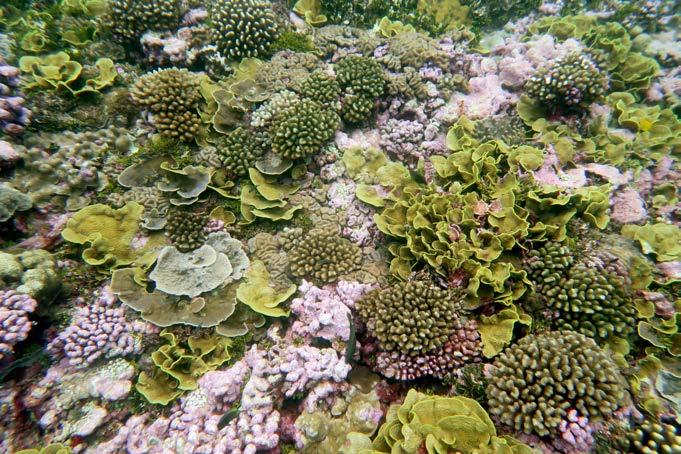
Citation: Fox, M., Guillaume-Castel, R., Edwards, C., Glanz, J., Gove, J. M., Green, M., Juhlin, E., Smith, J. & Williams, G. J. (2023). Ocean currents magnify upwelling and deliver nutritional subsidies to reef-building corals during El Niño heatwaves. Science Advances, In press.
 photo: Michael Fox
photo: Michael Fox
photo: Michael Fox
photo: Michael Fox
A new study published in Geophysical Research Letters, reveals that the surface temperature of Himalaya’s glaciers has increased at an even faster rate than the non-glacial regions, by nearly 1 °C over the last two decades. At the temperature peak in the autumn, glaciated areas of the Himalayas were twice as warm as nonglaciated areas.
The findings in this, the first paper to consider surface temperatures of Himalayan glaciers over long time scales, suggest that the data recorded is linked to large losses in glacier mass. The Himalayan glaciers are a source of vital fresh water to the surrounding population and downstream ecosystems. This loss of glacial mass also makes the glaciers themselves more hazardous.
Previous studies in this climate sensitive environment have primarily focused on air temperature changes measured from a limited number of ground-based observational stations, as well as from a number of satellite-derived land surface temperature products.
Dr Iestyn Woolway of Bangor University’s School of Ocean Sciences, a co-author of the paper, explains:
“In the past, people have looked at extremes in air temperature and at what we call marine heat waves, or extreme temperatures in the ocean. I have also been looking at similar heatwaves recorded in the surface temperatures of lakes. However, this paper which looks at the surface temperature of Himalayan glaciers shows how these areas in the Tibetan Plateau are reaching extreme levels more frequently and that’s worrying.”
Woolway adds: “Our study suggests that in recent years, high altitude areas have experienced a greater increase in heatwave duration both annually and seasonally between spring and autumn.
Under continued global warming, the Tibetan Plateau will likely experience accelerated warming this century, relative to historic trends.
It is expected high elevation regions will warm at a faster rate. As a result, longer lasting and more intense glacier surface heatwaves are likely to occur.”
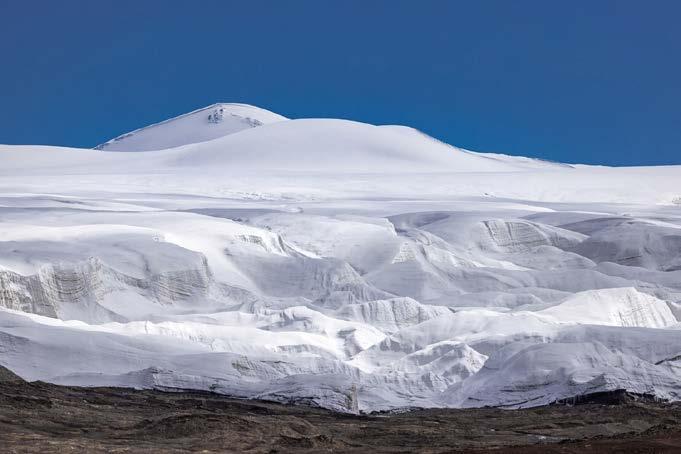

This study used satellite-derived land surface temperature data across the Tibetan Plateau. The analysis revealed an increase in the duration and cumulative intensity of glacier ‘heatwaves’ in the autumn. This work is a collaboration between researchers at the Institute of Tibetan Plateau Research, China and the School of Ocean Sciences.
Citation: Wenfeng Chen, Tandong Yao, Guoqing Zhang, R. Iestyn Woolway, Wei Yang, Fenglin Xu, and Tao Zhou. Glacier Surface Heatwaves Over the Tibetan Plateau. Geophysical Research Letter, 10.1029/2022GL101115.
The Tibetan Plateau, commonly referred to as “the roof of the world,” has experienced substantial warming during the past 50 years, at a rate twice that of the global average.
Macroalgae exhibit diverse responses to human disturbances on coral reefs
Cannon, S., Donner, S., Liu, A., Gonzalez Espinosa, P., Baird, A., Baum, J., Bauman, A., Beger, M., Benkwitt, C., Birt, M., Chancerelle, Y., Cinner, J., Crane, N., Denis, V., Depczynski, M., Fadli, N., Fenner, D., Fulton, C., Golbuu, Y., Graham, N., Guest, J., Harrison, H., Hobbs, J-P., Hoey, A., Holmes, T., Houk, P., Januchowski-Hartley, F., Jompa, J., Kuo, C-Y., Valentino Limmon, G., Lin, Y., McClanahan, T., Muenzel, D., Paddack, M., Planes, S., Pratchett, M., Radford, B., Reimer, J., Richards, Z., Ross, C., Rulmal Jr., J., Sommer, B., Williams, G. J. & Wilson, S., 1 Jun 2023, In: Global Change Biology. 29, 12, p. 3318-3330
The importance of resolving nearshore currents in coastal dispersal models
Ward, S., Robins, P., Owen, A., Demmer, J. & Jenkins, S., 1 Jun 2023, In: Ocean Modelling. 183, 102181.
Tidal range resource of the Patagonian shelf
Marti, V., Neill, S. & Angeloudis, A., 1 Jun 2023, In: Renewable Energy. 209, p. 85-96
Evaluating the accuracy and usefulness of commercially-available proximal soil mapping services for grassland nutrient management planning and soil health monitoring
Rhymes, J., Chadwick, D. R., Williams, A. P., Harris, I. M., Lark, R. M. & Jones, D. L., Jun 2023, In: Precision Agriculture. 24, 3, p. 898920 23 p.
Bycatch in northeast Atlantic lobster and crab pot fisheries (Irish Sea, Celtic Sea and Bristol Channel)
Moore, A., Heney, C., Lincoln, H., Colvin, C., Newell, H., Turner, B., McCarthy, I. & Hold, N., 1 Sep 2023, In: Fisheries Research. 265, 106745.
Ice Shelf Basal Melt Sensitivity to Tide-Induced Mixing Based on the Theory of Subglacial Plumes
Anselin, J., Reed, B., Jenkins, A. & Green, M., 30 Apr 2023, In: Journal of Geophysical Research: Oceans. 128, 4, e2022JC019156.
How Efficient Is Model-to-Model Data Assimilation atMitigating Atmospheric Forcing Errors in a Regional Ocean Model?
Shapiro, G. & Poovadiyil, S., 27 Apr 2023, In: Journal of Marine Science and Engineering . 11, 5
Microplastics in European sea salts – An example of exposure through consumer choice and of interstudy methodological discrepancies
Thiele, C., Grange, L., Haggett, E., Hudson, M., Hudson, P., Russell, A. & Zapata-Restrepo, L. M., 15 Apr 2023, In: Ecotoxicology and Environmental Safety. 255, 114782.
Ocean currents magnify upwelling and deliver nutritional subsidies to reef-building corals during El Niño heatwaves
Fox, M., Guillaume-Castel, R., Edwards, C., Glanz, J., Gove, J. M., Green, M., Juhlin, E., Smith, J. & Williams, G. J., 10 Apr 2023, (Accepted/In press) In: Science Advances.
Characterizing seabed sediments at contrasting offshore renewable energy sites
Amjadian, P., Neill, S. & Marti, V., 4 Apr 2023, In: Frontiers in Marine Science. 10
Field measurements of cable self-burial in a sandy marine environment
Unsworth, C., Austin, M., Van Landeghem, K., Couldrey, A., Whitehouse, R., Lincoln, B., Doole, S. & Worrall, P., 3 Apr 2023, (Accepted/In press) In: Coastal Engineering. 22 p.
Characterising the wave energy resource of Lanzarote, Canary Islands
Christie, D., Neill, S. & Arnold, P., 1 Apr 2023, In: Renewable Energy. 206, p. 1198-1211
Field Investigations of Scour Around Scaled Piles in a Region of Wave Breaking : Hydrodynamic Field Investigations on Scour around Piles
Kannapiran, T. & Neill, S., Apr 2023.
Selective foraging behavior of seabirds in small-scale slicks
Lieber, L., Füchtencordsjürgen, C., Hilder, R. L., Revering, P. J., Siekmann, I., Langrock, R. & Nimmo-Smith, W. A. M., Apr 2023, In: Limnology and Oceanography Letters. 8, 2, p. 286-294 9 p., 10289.
The UK’s first climate refugees: why more defences may not save this village from rising sea levels
Ward, S. & Austin, M., 31 Mar 2023, The Conversation.
Influence of upwelling on coral reef benthic communities: a systematic review and meta-analysis
Spring, D. & Williams, G. J., 29 Mar 2023, In: Proceedings of the Royal Society B: Biological Sciences. 290, 1995, p. 20230023 1 p.
Glacier Surface Heatwaves Over the Tibetan Plateau
Chen, W., Yao, T., Zhang, G., Woolway, R. I., Yang, W., Xu, F. & Zhou, T., 28 Mar 2023, In: Geophysical Research Letters. 50, 6, e2022GL101115.
A ray of hope? The re-appearance of Irish Sea skate decades after local extinction Moore, A., 20 Mar 2023, In: Journal of Fish Biology.
Characterizing the Marine Energy Test Area (META) in Wales, UK
Neill, S., Fairley, I., Rowlands, S., Young, S., Hill, T., Unsworth, C., King, N., Roberts, M., Austin, M., Hughes, P., Masters, I., Owen, A., Powell, B., Reeve, D. E. & Lewis, M., 1 Mar 2023, In: Renewable Energy. 205, p. 447-460
Numerical simulation of thermal stratification in Lake Qiandaohu using an improved WRF-Lake model
Wang, X., Wang, W., He, Y., Zhang, S., Huang, W., Woolway, R. I., Shi, K. & Yang, X., 1 Mar 2023, In: Journal of Hydrology. 618, 129184.
Poor air passenger knowledge of COVID-19 symptoms and behaviour undermines strategies aimed at preventing the import of SARS-CoV-2 into the UK
Jones, D. L., Rhymes, J., Green, E., Rimmer, C., Kevill, J., Malham, S., Weightman, A. & Farkas, K., 1 Mar 2023, In: Scientific Reports. 13, 1, 3494.
Co-occurrence of herbivorous fish functional groups correlates with enhanced coral reef benthic state
Sheppard, C., Williams, G. J., Exton, D. & Keith, S., Mar 2023, In: Global Ecology and Biogeography. 32, 3, p. 435-449 15 p.
Internet trade of a previously unknown wildlife product from a critically endangered marine fish
Pytka, J., Moore, A. & Heenan, A., Mar 2023, In: Conservation Science and Practice. 5, 3, e12896.
A standardized assessment of geographic variation in size at maturity of European lobster (Homarus gammarus L.) in the North East Atlantic
Coleman, M., Jenkins, S., Garratt, M., Hold, N., Bloor, I., Porter, J., Tully, O. & Bell, M., 21 Feb 2023, In: ICES Journal of Marine Science. fsac234.
Continued glacial retreat linked to changing macronutrient supply along the West Antarctic Peninsula. Jones, R., Meredith, M., Lohan, M., Woodward, E. M., Van Landeghem, K., Retallick, K., Flanagan, O., Vora, M. & Annett, A., 21 Feb 2023, (Accepted/In press) In: Marine Chemistry.
Rapid Assessment of SARS-CoV-2 Variant-Associated Mutations in Wastewater Using Real-Time RT-PCR
Farkas, K., Pellett, C., Williams, R., Alex-Sanders, N., Bassano, I., Brown, M. R., Denise, H., Grimsley, J. M. S., Kevill, J. L., Khalifa, M. S., Pântea, I., Story, R., Wade, M. J., Woodhall, N. & Jones, D. L., 14 Feb 2023, In: Microbiology Spectrum. 11, 1, e0317722.
A Comparison of Stochastic and Deterministic Downscaling in Eddy Resolving Ocean Modelling: The Lakshadweep Sea Case Study
Shapiro, G., Ondina, J., Poovadiyil, S. & Tu, J., 6 Feb 2023, In: Journal of Marine Science and Engineering . 11, 2
Applying landscape metrics to species distribution model predictions to characterize internal range structure and associated changes
Curd, A., Chevalier, M., Vasquez, M., Boye, A., Firth, L. B., Marzloff, M. P., Bricheno, L. M., Burrows, M. T., Bush, L. E., Cordier, C., Davies, A. J., Green, M., Hawkins, S. J., Lima, F. P., Meneghesso, C., Mieszkowska, N., Seabra, R. & Dubois, S. F., 1 Feb 2023, In: Global Change Biology. 29, 3, p. 631-647 17 p.
Climate tracking by freshwater fishes suggests that fish diversity in temperate lakes may be increasingly threatened by climate warming
Wu, T., Imrit, M. A., Movahedinia, Z., Kong, J., Woolway, R. I. & Sharma, S., 1 Feb 2023, In: Diversity and Distributions. 29, 2, p. 300315 16 p.
Interpretation of the European legal framework for the microbiological classification of bivalve mollusc production areas
Pinn, E. & Le Vay, L., 1 Feb 2023, In: Marine Policy. 148, 105479.
Does sand promote or hinder the mobility of cohesive sediment gravity flows?
Baker, M. L. & Baas, J., Feb 2023, In: Sedimentology. 70, 4, p. 1110-1130 21 p.
Prevalence and relative risk of rotavirus gastroenteritis in children under five years in Nigeria: A systematic review and meta-analysis
Digwo, D., Chidebelu, P., Ugwu, K., Adediji, A., Farkas, K. & Chigor, V., Feb 2023, In: Pathogens and Global Health. 117, 1, p. 24-35 12 p., 2043223.
Exploring regional coastal sediment pathways using a coupled tide-wave-sediment dynamics model
Davies, A. G., Robins, P., Austin, M. & Walker-Springett, G., 15 Jan 2023, In: Continental Shelf Research. 253, 104903.
Suitability of aircraft wastewater for pathogen detection and public health surveillance
Jones, D. L., Rhymes, J., Wade, M. J., Kevill, J., Malham, S., Grimsley, J. M. S., Rimmer, C., Weightman, A. & Farkas, K., 15 Jan 2023, In: Science of the Total Environment. 856, Pt 2, p. 159162 159162.
Beyond the tip of the seamount: Distinct megabenthic communities found beyond the charismatic summit sponge ground on an arctic seamount (Schulz Bank, Arctic Mid-Ocean Ridge)
Meyer, H. K., Davies, A. J., Roberts, E. M., Xavier, J. R., Ribeiro, P. A., Glenner, H., Birkely, S-R. & Rapp, H. T., 1 Jan 2023, In: Deep Sea Research Part I: Oceanographic Research Papers. 191, 1 p., 103920.
Historic Spatial Patterns of Storm-Driven Compound Events in UK Estuaries
Lyddon, C., Robins, P., Lewis, M., Barkwith, A., Vasilopoulos, G., Haigh, I. & Coulthard, T., Jan 2023, In: Estuaries and Coasts. 46, 1, p. 30-56 27 p.
Interannual Changes in Tidal Conversion Modulate M2 Amplitudes in the Gulf of Maine
Schindelegger, M., Kotzian, D. P., Ray, R., Green, M. & Stolzenberger, S., 28 Dec 2022, In: Geophysical Research Letters. 49, 24, p. e2022GL101671
Seasonal range fidelity of a megaherbivore in response to environmental change
Burton-Roberts, R., Cordes, L., Slotow, R., Vanak, A. T., Thaker, M., Govender, N. & Shannon, G., 22 Dec 2022, In: Scientific Reports.
Best practice for upscaling soil organic carbon stocks in salt marshes
Ladd, C. J. T., Smeaton, C., Skov, M. & Austin, W. E. N., 15 Dec 2022, In: Geoderma. 428, 116188.
Similar metabolic responses of co-occurring post-settlement mussels to temperature change despite distinct geographical distributions
Nel, A., Quaid, C. D., Duna, O. O., Gimenez Noya, L. & Porri, F., 2 Dec 2022, In: Marine Biology. 170, 2
Larval dispersal from an energetic tidal channel and implications for blue mussel (Mytilus edulis) shellfisheries
Demmer, J., Neill, S., Andres, O., Malham, S., Jones, T. & Robins, P., 1 Dec 2022, In: Aquaculture International. 30, 6, p. 2969-2995
Multi-model projections of future evaporation in a sub-tropical lake
La Fuente, S., Jennings, E., Gal, G., Kirillin, G., Shatwell, T., Ladwig, R., Moore, T., Couture, R-M., Cote, M., Vinna, C. L. R. & Woolway, R. I., Dec 2022, In: Journal of Hydrology. 615, 128729.
Internal tsunamigenesis and ocean mixing driven by glacier calving in Antarctica
Meredith, M., Inall, M., Brearley, A., Ehmen, T., Sheen, K., Munday, D., Cook, A., Retallick, K., Van Landeghem, K., Gerrish, L., Annett, A., Carvalho, F., Jones, R., Naveira-Garabato, A. C., Bull, C., Wallis, B., Hogg, A. & Scourse, J., 25 Nov 2022, In: Science Advances. 8, 47, p. eadd0720 eadd0720 .
An Ice-Ocean Model Study of the Mid-2000s Regime Change in the Barents Sea
Barton, B., Lique, C., Lenn, Y-D. & Talandier, C., 1 Nov 2022, In: Journal of Geophysical Research: Oceans. 127, 11, e2021JC018280.
Microplastics alter multiple biological processes of marine benthic fauna
Mason, V., Skov, M., Hiddink, J. G. & Walton, M., 1 Nov 2022, In: Science of the Total Environment. 845, 157362.
Spatial and Temporal variation of size at maturity in an intensive crustacean fishery with limited management
Moore, A., Delargy, A., Cann, R., Heney, C., Le Vay, L., Lincoln, H., McCarthy, I. & Hold, N., 1 Nov 2022, In: Fisheries Research. 255, November 2022, 106450.




